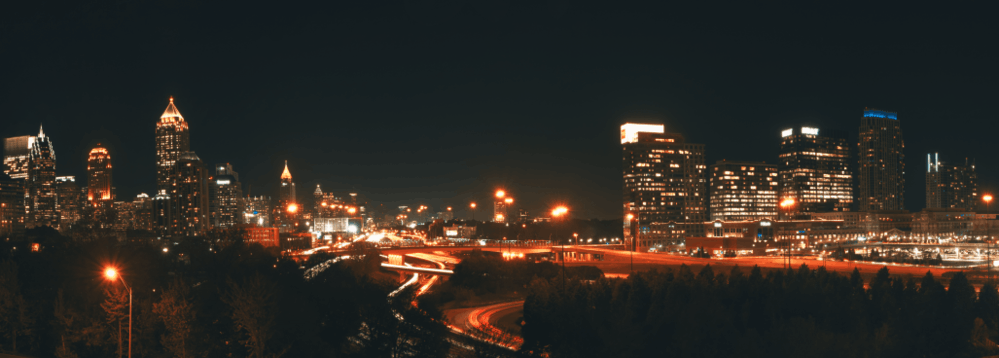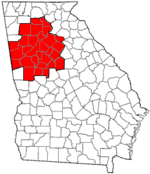Atlanta
Atlanta (/ætˈlæntə/) is the capital, most populous, and primate city of the U.S. state of Georgia. With an estimated 2018 population of 498,044,[7] it is also the 37th most populous city in the United States. The city serves as the cultural and economic center of the Atlanta metropolitan area, home to 5.9 million people and the ninth-largest metropolitan area in the nation.[3] Atlanta is the seat of Fulton County, the most populous county in Georgia. Portions of the city extend eastward into neighboring DeKalb County. The city is situated among the foothills of the Appalachian Mountains and has one of the highest elevations among major cities east of the Mississippi River.[8]
Atlanta, Georgia | |
|---|---|
State capital and city | |
| City of Atlanta | |
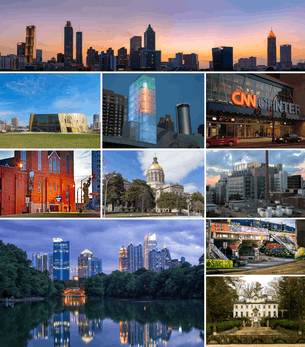  From top to bottom, left to right: Downtown Atlanta skyline seen from Old Fourth Ward, the Center for Civil and Human Rights, World of Coca-Cola, CNN Center, Ebenezer Baptist Church at the Martin Luther King Jr. National Historical Park, the Georgia State Capitol, the Centers for Disease Control and Prevention, Midtown Atlanta skyline from Piedmont Park, Krog Street Tunnel, and Swan House at the Atlanta History Center | |
 Flag  Seal | |
| Nickname(s): The City in a Forest, The ATL, The A, Nicknames of Atlanta | |
| Motto(s): Resurgens (Latin for rising again) | |
 City highlighted in Fulton County, location of Fulton County in the state of Georgia | |
 Atlanta Location within Georgia  Atlanta Location within the United States 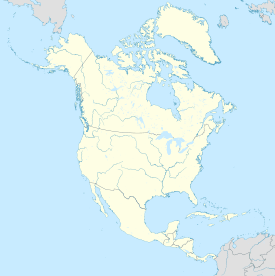 Atlanta Atlanta (North America) | |
| Coordinates: 33°45′18″N 84°23′24″W | |
| Country | |
| State | |
| Counties | Fulton, DeKalb |
| Terminus | 1837 |
| Marthasville | 1843 |
| City of Atlanta | December 29, 1847 |
| Government | |
| • Mayor | Keisha Lance Bottoms (D) |
| • Body | Atlanta City Council |
| Area | |
| • State capital and city | 136.76 sq mi (354.22 km2) |
| • Land | 135.73 sq mi (351.53 km2) |
| • Water | 1.04 sq mi (2.68 km2) |
| • Urban | 1,963 sq mi (5,080 km2) |
| • Metro | 8,376 sq mi (21,690 km2) |
| Elevation | 738 to 1,050 ft (225 to 320 m) |
| Population (2010) | |
| • State capital and city | 420,003 |
| • Estimate (2018)[2] | 498,044 |
| • Rank | U.S.: 37th |
| • Density | 3,669.45/sq mi (1,416.78/km2) |
| • Urban | 4,975,300 |
| • Urban density | 5,180/sq mi (1,999/km2) |
| • Metro | 5,949,951[3] (9th) |
| • Metro density | 1,350/sq mi (522/km2) |
| • CSA | 6,775,511[4] (11th) |
| • Demonym | Atlantan[lower-alpha 1] |
| Time zone | UTC−5 (EST) |
| • Summer (DST) | UTC−4 (EDT) |
| ZIP Codes | 30060, 30301–30322, 30324–30334, 30336–30350, 30340, 30353, 30363 |
| Area codes | 404/678/470/770 |
| FIPS code | 13-04000[5] |
| GNIS feature ID | 0351615[6] |
| Interstates | |
| Rapid Transit | |
| Website | atlantaga |
Atlanta was originally founded as the terminus of a major state-sponsored railroad. With rapid expansion, however, it soon became the convergence point among multiple railroads, spurring its rapid growth. The city's name derives from that of the Western and Atlantic Railroad's local depot, signifying the town's growing reputation as a transportation hub.[9] During the American Civil War, the city was almost entirely burned to the ground in General William T. Sherman's famous March to the Sea. However, the city rose from its ashes and quickly became a national center of commerce and the unofficial capital of the "New South". During the 1950s and 1960s, Atlanta became a major organizing center of the civil rights movement, with Dr. Martin Luther King Jr., Ralph David Abernathy, and many other locals playing major roles in the movement's leadership.[10] During the modern era, Atlanta has attained international prominence as a major air transportation hub, with Hartsfield–Jackson Atlanta International Airport being the world's busiest airport by passenger traffic since 1998.[11][12][13][14]
It ranks in the top twenty among world cities and 10th in the nation with a gross domestic product (GDP) of $385 billion.[15][16] Atlanta's economy is considered diverse, with dominant sectors that include aerospace, transportation, logistics, professional and business services, media operations, medical services, and information technology.[17] Atlanta has topographic features that include rolling hills and dense tree coverage, earning it the nickname of "the city in a forest."[18] Revitalization of Atlanta's neighborhoods, initially spurred by the 1996 Summer Olympics, has intensified in the 21st century, altering the city's demographics, politics, aesthetics, and culture.[19][20]
History
The Atlanta area was first settled by the Creek and Cherokee tribes to trade with the English.[21]
Western and Atlantic Railroad
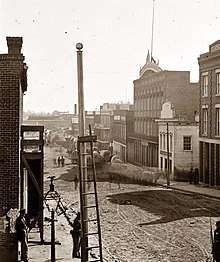
In 1836, the Georgia General Assembly voted to build the Western and Atlantic Railroad in order to provide a link between the port of Savannah and the Midwest.[22] The initial route was to run southward from Chattanooga to a terminus east of the Chattahoochee River, which would be linked to Savannah. After engineers surveyed various possible locations for the terminus, the "zero milepost" was driven into the ground in what is now Five Points. A year later, the area around the milepost had developed into a settlement, first known as Terminus, and later Thrasherville, after a local merchant who built homes and a general store in the area.[23] By 1842, the town had six buildings and 30 residents and was renamed Marthasville to honor Governor Wilson Lumpkin's daughter Martha. Later, J. Edgar Thomson, Chief Engineer of the Georgia Railroad, suggested the town be renamed Atlanta.[24] The residents approved, and the town was incorporated as Atlanta on December 29, 1847.[25]
Civil War
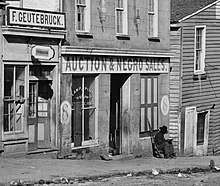
By 1860, Atlanta's population had grown to 9,554.[26][27] During the American Civil War, the nexus of multiple railroads in Atlanta made the city a strategic hub for the distribution of military supplies.
In 1864, the Union Army moved southward following the capture of Chattanooga and began its invasion of north Georgia. The region surrounding Atlanta was the location of several major army battles, culminating with the Battle of Atlanta and a four-month-long siege of the city by the Union Army under the command of General William Tecumseh Sherman. On September 1, 1864, Confederate General John Bell Hood made the decision to retreat from Atlanta, and he ordered the destruction of all public buildings and possible assets that could be of use to the Union Army. On the next day, Mayor James Calhoun surrendered Atlanta to the Union Army, and on September 7, Sherman ordered the city's civilian population to evacuate. On November 11, 1864, Sherman prepared for the Union Army's March to the Sea by ordering the destruction of Atlanta's remaining military assets.[28]
Rebuilding the city
After the Civil War ended in 1865, Atlanta was gradually rebuilt. The work attracted many new residents. Due to the city's superior rail transportation network, the state capital was moved from Milledgeville to Atlanta in 1868.[29] In the 1880 Census, Atlanta had surpassed Savannah as Georgia's largest city.
Beginning in the 1880s, Henry W. Grady, the editor of the Atlanta Constitution newspaper, promoted Atlanta to potential investors as a city of the "New South" that would be based upon a modern economy and less reliant on agriculture. By 1885, the founding of the Georgia School of Technology (now Georgia Tech) and the Atlanta University Center, a historically black college made up of units for men and women, had established Atlanta as a center for higher education. In 1895, Atlanta hosted the Cotton States and International Exposition, which attracted nearly 800,000 attendees and successfully promoted the New South's development to the world.[30]
20th century
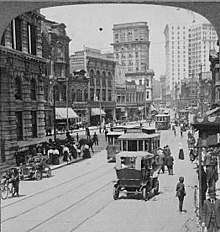
During the first decades of the 20th century, Atlanta enjoyed a period of unprecedented growth. In three decades' time, Atlanta's population tripled as the city limits expanded to include nearby streetcar suburbs. The city's skyline grew taller with the construction of the Equitable, Flatiron, Empire, and Candler buildings. Sweet Auburn emerged as a center of black commerce. The period was also marked by strife and tragedy. Increased racial tensions led to the Atlanta Race Riot of 1906, when whites attacked blacks, leaving at least 27 people dead and over 70 injured, with extensive damage in black neighborhoods. In 1913, Leo Frank, a Jewish-American factory superintendent, was convicted of the murder of a 13-year-old girl in a highly publicized trial. He was sentenced to death but the governor commuted his sentence to life. An enraged and organized lynch mob took him from jail in 1915 and hanged him in Marietta. The Jewish community in Atlanta and across the country were horrified.[31][32] On May 21, 1917, the Great Atlanta Fire destroyed 1,938 buildings in what is now the Old Fourth Ward, resulting in one fatality and the displacement of 10,000 people.[24]
On December 15, 1939, Atlanta hosted the premiere of Gone with the Wind, the epic film based on the best-selling novel by Atlanta's Margaret Mitchell. The gala event at Loew's Grand Theatre was attended by the film's legendary producer, David O. Selznick, and the film's stars Clark Gable, Vivien Leigh, and Olivia de Havilland, but Oscar winner Hattie McDaniel, an African-American actress, was barred from the event due to racial segregation laws.[33]
Metropolitan area's growth
Atlanta played a vital role in the Allied effort during World War II due to the city's war-related manufacturing companies, railroad network and military bases. The defense industries attracted thousands of new residents and generated revenues, resulting in rapid population and economic growth. In the 1950s, the city's newly constructed highway system, supported by federal subsidies, allowed middle class Atlantans the ability to relocate to the suburbs. As a result, the city began to make up an ever-smaller proportion of the metropolitan area's population.[24]
Civil rights movement
African-American veterans returned from World War II seeking full rights in their country and began heightened activism. In exchange for support by that portion of the black community that could vote, in 1948 the mayor ordered the hiring of the first eight African-American police officers in the city. In the 1960s, Atlanta became a major organizing center of the civil rights movement, with Dr. Martin Luther King, Jr., Ralph David Abernathy, and students from Atlanta's historically black colleges and universities playing major roles in the movement's leadership. While Atlanta in the postwar years had relatively minimal racial strife compared to other cities, blacks were limited by discrimination, segregation, and continued disenfranchisement of most voters.[34] In 1961, the city attempted to thwart blockbusting by realtors by erecting road barriers in Cascade Heights, countering the efforts of civic and business leaders to foster Atlanta as the "city too busy to hate".[34][35]
Desegregation of the public sphere came in stages, with public transportation desegregated by 1959,[36] the restaurant at Rich's department store by 1961,[37] movie theaters by 1963,[38] and public schools by 1973 (nearly 20 years after the US Supreme Court ruled that segregated public schools were unconstitutional).[39] In the private sphere, The Westminster Schools desegregated in 1967.[40]
In 1960, whites comprised 61.7% of the city's population.[41] During the 1950s–70s, suburbanization and white flight from urban areas led to a significant demographic shift.[34] By 1970, African Americans were the majority of the city's population and exercised their recently enforced voting rights and political influence by electing Atlanta's first black mayor, Maynard Jackson, in 1973. Under Mayor Jackson's tenure, Atlanta's airport was modernized, strengthening the city's role as a transportation center. The opening of the Georgia World Congress Center in 1976 heralded Atlanta's rise as a convention city.[42] Construction of the city's subway system began in 1975, with rail service commencing in 1979.[43] Despite these improvements, Atlanta lost more than 100,000 residents between 1970 and 1990, over 20% of its population.[44] At the same time, it developed new office space after attracting numerous corporations, with an increasing portion of workers from northern areas.
1996 Summer Olympic Games
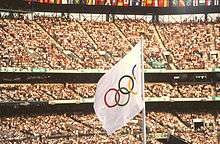
Atlanta was selected as the site for the 1996 Summer Olympic Games. Following the announcement, the city government undertook several major construction projects to improve Atlanta's parks, sporting venues, and transportation infrastructure. While the games were marred by numerous organizational inefficiencies, as well as the Centennial Olympic Park bombing,[45] the spectacle was a watershed event in Atlanta's history. The related projects such as Atlanta's Olympic Legacy Program and civic effort initiated a fundamental transformation of the city in the following decade.[44]
2000 to present
During the 2000s, Atlanta underwent a profound physical, cultural, and demographic transformation. As some of the black middle and upper classes also began to move to the suburbs, a booming economy drew numerous new migrants from other areas of the country, who contributed to changes in the city's demographics. African Americans made up a decreasing portion of the population, from a high of 67% in 1990 to 54% in 2010.[46] From 2000 to 2010, Atlanta gained 22,763 white residents, 5,142 Asian residents, and 3,095 Hispanic residents, while the city's black population decreased by 31,678.[47][48] Much of the city's demographic change during the decade was driven by young, college-educated professionals: from 2000 to 2009, the three-mile radius surrounding Downtown Atlanta gained 9,722 residents aged 25 to 34 and holding at least a four-year degree, an increase of 61%.[49] This was similar to the tendency in other cities for young, college educated, single or married couples to live in downtown areas.[50]
Between the mid-1990s and 2010, stimulated by funding from the HOPE VI program and under leadership of CEO Renee Lewis Glover (1994–2013),[51] the Atlanta Housing Authority demolished nearly all of its public housing, a total of 17,000 units and about 10% of all housing units in the city.[52][53][54] After reserving 2,000 units mostly for elderly, the AHA allowed redevelopment of the sites for mixed-use and mixed-income, higher density developments, with 40% of the units to be reserved for affordable housing. Two-fifths of previous public housing residents attained new housing in such units; the remainder received vouchers to be used at other units, including in suburbs. At the same time, in an effort to change the culture of those receiving subsidized housing, the AHA imposed a requirement for such residents to work (or be enrolled in a genuine, limited-time training program). It is virtually the only housing authority to have created this requirement. To prevent problems, the AHA also gave authority to management of the mixed-income or voucher units to evict tenants who did not comply with the work requirement or who caused behavior problems.[55]
In 2005, the city approved the $2.8 billion BeltLine project. It was intended to convert a disused 22-mile freight railroad loop that surrounds the central city into an art-filled multi-use trail, which would increase the city's park space by 40%.[56] The project stimulated retail and residential development along the loop.
Atlanta's cultural offerings expanded during the 2000s: the High Museum of Art doubled in size; the Alliance Theatre won a Tony Award; and art galleries were established on the once-industrial Westside.[57] The city of Atlanta was the subject of a massive cyberattack which began in March 2018.[58]
Geography
Atlanta encompasses 134.0 square miles (347.1 km2), of which 133.2 square miles (344.9 km2) is land and 0.85 square miles (2.2 km2) is water.[59] The city is situated among the foothills of the Appalachian Mountains. At 1,050 feet (320 m) above mean sea level, Atlanta has one of the highest elevations among major cities east of the Mississippi River.[60] Atlanta straddles the Eastern Continental Divide. Rainwater that falls on the south and east side of the divide flows into the Atlantic Ocean, while rainwater on the north and west side of the divide flows into the Gulf of Mexico.[61] Atlanta developed on a ridge south of the Chattahoochee River, which is part of the ACF River Basin. The river borders the far northwestern edge of the city, and much of its natural habitat has been preserved, in part by the Chattahoochee River National Recreation Area.[62]
Cityscape
Most of Atlanta was burned during the Civil War, depleting the city of a large stock of its historic architecture. Yet architecturally, the city had never been traditionally "southern" because Atlanta originated as a railroad town, rather than a southern seaport dominated by the planter class, such as Savannah or Charleston. Because of its later development, many of the city's landmarks share architectural characteristics with buildings in the Northeast or Midwest, as they were designed at a time of shared national architectural styles.[63]
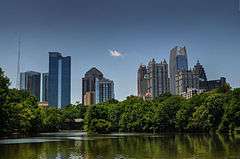
During the later twentieth century, Atlanta embraced global modernist trends, especially regarding commercial and institutional architecture. Examples of modernist architecture include the 1,196,240-square-foot (111,134 m2)[64] Westin Peachtree Plaza (1976), Georgia-Pacific Tower (1982), the State of Georgia Building (1966), and the Atlanta Marriott Marquis (1985). In the latter half of the 1980s, Atlanta became one of the early adopters of postmodern designs that reintroduced classical elements to the cityscape. Many of Atlanta's tallest skyscrapers were built in the late 1980s and early 1990s, with most displaying tapering spires or otherwise ornamented crowns, such as the 1,187,676-square-foot (110,338.7 m2)[65] One Atlantic Center (1987), 191 Peachtree Tower (1991), and the Four Seasons Hotel Atlanta (1992). Also completed during the era is Atlanta's tallest skyscraper, the Bank of America Plaza (1992), which, at 1,023 feet (312 m), is the 61st-tallest building in the world and the 14th-tallest building in the United States. The Bank of America Plaza is the tallest building outside of New York City, Chicago, Philadelphia, Los Angeles, and San Francisco. It was the last building built in the United States to be in the top 10 tallest buildings in the world until One World Trade Center was completed externally in May 2013.[66] The city's embrace of modern architecture translated into an ambivalent approach toward historic preservation, leading to the destruction of notable architectural landmarks, including the Equitable Building (1892–1971), Terminal Station (1905–1972), and the Carnegie Library (1902–1977). The Fox Theatre (1929)—Atlanta's cultural icon—would have met the same fate had it not been for a grassroots effort in the mid-1970s to save it.[63]
Atlanta is divided into 242 officially defined neighborhoods.[67][68][69] The city contains three major high-rise districts, which form a north–south axis along Peachtree: Downtown, Midtown, and Buckhead.[70] Surrounding these high-density districts are leafy, low-density neighborhoods, most of which are dominated by single-family homes.[71]
Downtown Atlanta contains the most office space in the metro area, much of it occupied by government entities. Downtown is home to the city's sporting venues and many of its tourist attractions. Midtown Atlanta is the city's second-largest business district, containing the offices of many of the region's law firms. Midtown is known for its art institutions, cultural attractions, institutions of higher education, and dense form.[72] Buckhead, the city's uptown district, is eight miles (13 km) north of Downtown and the city's third-largest business district. The district is marked by an urbanized core along Peachtree Road, surrounded by suburban single-family neighborhoods situated among woods and rolling hills.[73]
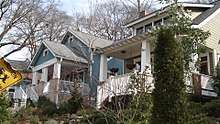
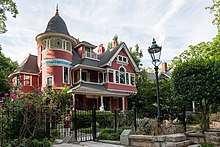
Surrounding Atlanta's three high-rise districts are the city's low- and medium-density neighborhoods,[73] where the craftsman bungalow single-family home is dominant.[74] The eastside is marked by historic streetcar suburbs, built from the 1890s–1930s as havens for the upper middle class. These neighborhoods, many of which contain their own villages encircled by shaded, architecturally distinct residential streets, include the Victorian Inman Park, Bohemian East Atlanta, and eclectic Old Fourth Ward.[63][75] On the westside and along the BeltLine on the eastside, former warehouses and factories have been converted into housing, retail space, and art galleries, transforming the once-industrial areas such as West Midtown into model neighborhoods for smart growth, historic rehabilitation, and infill construction.[76]
In southwest Atlanta, neighborhoods closer to downtown originated as streetcar suburbs, including the historic West End, while those farther from downtown retain a postwar suburban layout. These include Collier Heights and Cascade Heights, home to much of the city's affluent African-American population.[77][78][79] Northwest Atlanta contains the areas of the city to west of Marietta Boulevard and to the north of Martin Luther King, Jr. Drive, including those neighborhoods remote to downtown, such as Riverside, Bolton and Whittier Mill. The latter is one of Atlanta's designated Landmark Historical Neighborhoods. Vine City, though technically Northwest, adjoins the city's Downtown area and has recently been the target of community outreach programs and economic development initiatives.[80]
Gentrification of the city's neighborhoods is one of the more controversial and transformative forces shaping contemporary Atlanta. The gentrification of Atlanta has its origins in the 1970s, after many of Atlanta's neighborhoods had declined and suffered the urban decay that affected other major American cities in the mid-20th century. When neighborhood opposition successfully prevented two freeways from being built through the city's east side in 1975, the area became the starting point for Atlanta's gentrification. After Atlanta was awarded the Olympic games in 1990, gentrification expanded into other parts of the city, stimulated by infrastructure improvements undertaken in preparation for the games. New development post-2000 has been aided by the Atlanta Housing Authority's eradication of the city's public housing. As noted above, it allowed development of these sites for mixed-income housing, requiring developers to reserve a considerable portion for affordable housing units. It has also provided for other former residents to be given vouchers to gain housing in other areas.[55] Construction of the Beltline has stimulated new and related development along its path.[81]
Climate
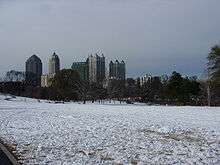
Atlanta has a humid subtropical climate (Cfa) according to the Köppen classification,[82] with the seasons more or less defined. The winter has a shorter duration, with hot and humid summers and mild winters (in some cases the outbreaks are cold), but susceptible to snowstorms even if in small quantities on several occasions, unlike the rest of the southeastern United States.[83] Winters are mild but variable, with an average of 48 freezing days per year,[84] though temperatures very rarely drop even close to 0 °F (−17.8 °C).[24][85] Warm air from the Gulf of Mexico can bring spring-like highs while strong Arctic air masses can push lows into the teens °F (−7 to −12 °C).
July averages 80.2 °F (26.8 °C), with high temperatures reaching 90 °F (32 °C) on an average 44 days per year, though 100 °F (38 °C) readings are not seen most years. January averages 43.5 °F (6.4 °C), with temperatures in the suburbs slightly cooler due largely to the urban heat island effect. Lows at or below freezing can be expected 40 nights annually,[86] but extended stretches with daily high temperatures below 40 °F (4 °C) are very rare, with a recent exception in January 2014. Extremes range from −9 °F (−23 °C) on February 13, 1899 to 106 °F (41 °C) on June 30, 2012.[87] Average dewpoints in the summer range from 63.6 °F (18 °C) in June to 67.8 °F (20 °C) in July. According to the USDA, Atlanta is situated in Hardiness Zone 8a, with northern and western suburbs transitioning to 7b.[88]
Typical of the southeastern U.S., Atlanta receives abundant rainfall that is evenly distributed throughout the year, though late spring and early fall are somewhat drier. The average annual rainfall is 50.2 inches (1,280 mm), while snowfall is typically light at around 2.9 to 5 inches per year.[89] The heaviest single snowfall occurred on January 23, 1940, with around 10 inches (25 cm) of snow.[90] However, ice storms usually cause more problems than snowfall does, the most severe occurring on January 7, 1973. Tornadoes are rare in the city, but the March 14, 2008 EF2 tornado damaged prominent structures in downtown Atlanta.
| Climate data for Atlanta (Hartsfield–Jackson Int'l), 1981–2010 normals,[lower-alpha 2] extremes 1878–present[lower-alpha 3] | |||||||||||||
|---|---|---|---|---|---|---|---|---|---|---|---|---|---|
| Month | Jan | Feb | Mar | Apr | May | Jun | Jul | Aug | Sep | Oct | Nov | Dec | Year |
| Record high °F (°C) | 79 (26) |
80 (27) |
89 (32) |
93 (34) |
97 (36) |
106 (41) |
105 (41) |
104 (40) |
102 (39) |
98 (37) |
84 (29) |
79 (26) |
106 (41) |
| Mean maximum °F (°C) | 69.6 (20.9) |
73.2 (22.9) |
80.8 (27.1) |
85.0 (29.4) |
89.3 (31.8) |
94.6 (34.8) |
96.3 (35.7) |
95.4 (35.2) |
91.4 (33.0) |
84.4 (29.1) |
77.5 (25.3) |
70.8 (21.6) |
97.6 (36.4) |
| Average high °F (°C) | 52.3 (11.3) |
56.6 (13.7) |
64.6 (18.1) |
72.5 (22.5) |
79.9 (26.6) |
86.4 (30.2) |
89.1 (31.7) |
88.1 (31.2) |
82.2 (27.9) |
72.7 (22.6) |
63.6 (17.6) |
54.0 (12.2) |
71.9 (22.2) |
| Daily mean °F (°C) | 43.3 (6.3) |
47.2 (8.4) |
54.3 (12.4) |
62.0 (16.7) |
70.1 (21.2) |
77.3 (25.2) |
80.2 (26.8) |
79.4 (26.3) |
73.5 (23.1) |
63.3 (17.4) |
54.0 (12.2) |
45.3 (7.4) |
62.6 (17.0) |
| Average low °F (°C) | 34.3 (1.3) |
37.7 (3.2) |
44.1 (6.7) |
51.5 (10.8) |
60.3 (15.7) |
68.2 (20.1) |
71.3 (21.8) |
70.7 (21.5) |
64.8 (18.2) |
54.0 (12.2) |
44.5 (6.9) |
36.5 (2.5) |
53.2 (11.8) |
| Mean minimum °F (°C) | 15.7 (−9.1) |
20.9 (−6.2) |
27.4 (−2.6) |
35.2 (1.8) |
47.6 (8.7) |
58.5 (14.7) |
65.1 (18.4) |
63.7 (17.6) |
51.4 (10.8) |
38.5 (3.6) |
29.5 (−1.4) |
20.0 (−6.7) |
12.1 (−11.1) |
| Record low °F (°C) | −8 (−22) |
−9 (−23) |
10 (−12) |
25 (−4) |
37 (3) |
39 (4) |
53 (12) |
55 (13) |
36 (2) |
28 (−2) |
3 (−16) |
0 (−18) |
−9 (−23) |
| Average precipitation inches (mm) | 4.20 (107) |
4.67 (119) |
4.81 (122) |
3.36 (85) |
3.67 (93) |
3.95 (100) |
5.27 (134) |
3.90 (99) |
4.47 (114) |
3.41 (87) |
4.10 (104) |
3.90 (99) |
49.71 (1,263) |
| Average snowfall inches (cm) | 1.3 (3.3) |
0.4 (1.0) |
0.8 (2.0) |
0 (0) |
0 (0) |
0 (0) |
0 (0) |
0 (0) |
0 (0) |
0 (0) |
0 (0) |
0.4 (1.0) |
2.9 (7.4) |
| Average precipitation days (≥ 0.01 in) | 10.9 | 9.8 | 9.7 | 8.6 | 9.3 | 9.9 | 11.7 | 9.7 | 7.5 | 6.9 | 8.8 | 10.5 | 113.3 |
| Average snowy days (≥ 0.1 in) | 0.8 | 0.6 | 0.3 | 0 | 0 | 0 | 0 | 0 | 0 | 0 | 0 | 0.4 | 2.1 |
| Average relative humidity (%) | 67.6 | 63.4 | 62.4 | 61.0 | 67.2 | 69.8 | 74.4 | 74.8 | 73.9 | 68.5 | 68.1 | 68.4 | 68.3 |
| Mean monthly sunshine hours | 164.0 | 171.7 | 220.5 | 261.2 | 288.6 | 284.8 | 273.8 | 258.6 | 227.5 | 238.5 | 185.1 | 164.0 | 2,738.3 |
| Percent possible sunshine | 52 | 56 | 59 | 67 | 67 | 66 | 63 | 62 | 61 | 68 | 59 | 53 | 62 |
| Source: NOAA (relative humidity and sun 1961–1990)[92][93][94] | |||||||||||||
| Climate data for Atlanta | |||||||||||||
|---|---|---|---|---|---|---|---|---|---|---|---|---|---|
| Month | Jan | Feb | Mar | Apr | May | Jun | Jul | Aug | Sep | Oct | Nov | Dec | Year |
| Mean daily daylight hours | 10.0 | 11.0 | 12.0 | 13.0 | 14.0 | 14.0 | 14.0 | 13.0 | 12.0 | 11.0 | 10.0 | 10.0 | 12.0 |
| Average Ultraviolet index | 3 | 5 | 6 | 8 | 9 | 10 | 10 | 10 | 8 | 6 | 4 | 3 | 6.8 |
| Source: Weather Atlas [95] | |||||||||||||
Demographics
| Historical population | |||
|---|---|---|---|
| Census | Pop. | %± | |
| 1850 | 2,572 | — | |
| 1860 | 9,554 | 271.5% | |
| 1870 | 21,789 | 128.1% | |
| 1880 | 37,409 | 71.7% | |
| 1890 | 65,533 | 75.2% | |
| 1900 | 89,872 | 37.1% | |
| 1910 | 154,839 | 72.3% | |
| 1920 | 200,616 | 29.6% | |
| 1930 | 270,366 | 34.8% | |
| 1940 | 302,288 | 11.8% | |
| 1950 | 331,314 | 9.6% | |
| 1960 | 487,455 | 47.1% | |
| 1970 | 495,039 | 1.6% | |
| 1980 | 425,022 | −14.1% | |
| 1990 | 394,017 | −7.3% | |
| 2000 | 416,474 | 5.7% | |
| 2010 | 420,003 | 0.8% | |
| Est. 2018 | 498,044 | [2] | 18.6% |
| U.S. Decennial Census[41] | |||
| Racial composition | 2014[96] | 1990[41] | 1970[41] | 1940[41] |
|---|---|---|---|---|
| Black or African American | 51.4% | 67.1% | 51.3% | 34.6% |
| White | 41.3% | 31.0% | 48.4% | 65.4% |
| Asian | 3.7% | 0.9% | 0.1% | - |
| Hispanic or Latino (of any race) | 4.7% | 1.9% | 1.5% | n/a |
The 2010 United States Census reported that Atlanta had a population of 420,003. The population density was 3,154 per square mile (1232/km2). The racial makeup and population of Atlanta was 54.0% Black or African American, 38.4% White, 3.1% Asian and 0.2% Native American. Those from some other race made up 2.2% of the city's population, while those from two or more races made up 2.0%. Hispanics of any race made up 5.2% of the city's population.[97] The median income for a household in the city was $45,171. The per capita income for the city was $35,453. 22.6% percent of the population was living below the poverty line.
Atlanta has one of the highest LGBT populations per capita, according to a survey by the Williams Institute, ranking third among major American cities, behind San Francisco and slightly behind Seattle, with 12.8% of the city's total population identifying as lesbian, gay, bisexual, or transgender.[98]
.png)
In the 2010 Census, Atlanta was recorded as the nation's fourth-largest majority-black city. The New Great Migration has brought an insurgence of African Americans from California[99] and the North to the Atlanta area.[100] It has long been known as a center of African-American political power, education, economic prosperity, and culture, often called a black mecca.[101][102][103] Some middle and upper class African-American residents of Atlanta followed an influx of whites to newer housing and public schools in the suburbs in the early 21st century. From 2000 to 2010, the city's black population decreased by 31,678 people, shrinking from 61.4% of the city's population in 2000 to 54.0% in 2010, as the overall population expanded and migrants increased from other areas.[47]
At the same time, the white population of Atlanta has increased. Between 2000 and 2010, the proportion of whites in the city's population grew faster than in any other U.S. city. In that decade, Atlanta's white population grew from 31% to 38% of the city's population, an absolute increase of 22,753 people, more than triple the increase that occurred between 1990 and 2000.[104]
Of the total population five years and older, 83.3% spoke only English at home, while 8.8% spoke Spanish, 3.9% another Indo-European language, and 2.8% an Asian language.[105] 7.3% of Atlantans were born abroad (86th in the US).[97][106] Atlanta's dialect has traditionally been a variation of Southern American English. The Chattahoochee River long formed a border between the Coastal Southern and Southern Appalachian dialects.[107] Because of the development of corporate headquarters in the region, attracting migrants from other areas of the country, by 2003, Atlanta magazine concluded that Atlanta had become significantly "de-Southernized." A Southern accent was considered a handicap in some circumstances.[108] In general, Southern accents are less prevalent among residents of the city and inner suburbs and among younger people; they are more common in the outer suburbs and among older people.[107] At the same time, some residents of the city speak in Southern variations of African-American English.[109]
Religion in Atlanta, while historically centered on Protestant Christianity, now encompasses many faiths, as a result of the city and metro area's increasingly international population. Some 63% of residents identify as some type of Protestant,[110][111] but in recent decades the Catholic Church has increased in numbers and influence because of new migrants to the region. Metro Atlanta also has numerous ethnic or national Christian congregations, including Korean and Indian churches. The larger non-Christian faiths are Judaism, Islam, and Hinduism. Overall, there are over 1,000 places of worship within Atlanta.[112]
Early immigrants in Atlanta were Jews and Greeks. Since 1970, the Latino immigrant population, especially Mexicans, has experienced the most rapid growth, mainly in Gwinnett, Cobb, and DeKalb counties.[113] Since 2010, the Atlanta area has seen very notable growth with immigrants from India, China, South Korea, and Jamaica.[114][115] Other notable countries immigrants come from are Vietnam, Eritrea, Nigeria, the Arabian gulf, Ukraine and Poland.[116]
Economy
With a GDP of $385 billion,[16] the Atlanta metropolitan area's economy is the tenth-largest in the country and among the top 20-largest in the world. Corporate operations play a major role in Atlanta's economy, as the city claims the nation's third-largest concentration of Fortune 500 companies. It also hosts the global headquarters of corporations like The Coca-Cola Company, The Home Depot, Delta Air Lines, AT&T Mobility, Chick-fil-A, and UPS. Over 75% of Fortune 1000 companies conduct business operations in the city's metro area, and the region hosts offices of over 1,250 multinational corporations.[117] Many corporations are drawn to the city by its educated workforce; as of 2014, 45% of adults aged 25 or older residing in the city have at least 4-year college degrees, compared to the national average of 28%.[118][119][120]
Atlanta started as a railroad town, and logistics has been a major component of the city's economy to this day. Atlanta serves as an important rail junction and contains major classification yards for Norfolk Southern and CSX. Since its construction in the 1950s, Hartsfield–Jackson Atlanta International Airport has served as a key engine of the city's economic growth.[121] Delta Air Lines, the city's largest employer and the metro area's third-largest, operates the world's largest airline hub at Hartsfield-Jackson, and it has helped make it the world's busiest airport, in terms of both passenger traffic and aircraft operations.[122] Partly due to the airport, Atlanta has been also a hub for diplomatic missions; as of 2017, the city contains 26 consulates general, the seventh-highest concentration of diplomatic missions in the US.[123]
Media is also an important aspect of Atlanta's economy. In fact, the city is even a major cable television programming center. Ted Turner established the headquarters of both the Cable News Network (CNN) and the Turner Broadcasting System (TBS) in the city. Cox Enterprises, the nation's third-largest cable television service and the publisher of over a dozen American newspapers, is headquartered in the city.[124] The Weather Channel is headquartered just outside of Atlanta in suburban Cobb County.

Information technology—a business sector that includes publishing, software development, entertainment and data processing—has garnered a larger percentage of Atlanta's economic output. Atlanta has, indeed, been nicknamed the "Silicon peach" thanks to its burgeoning technology sector. As of 2013, Atlanta contains the fourth-largest concentration of information technology jobs in the US, numbering 85,000+. The city also is ranked as the sixth fastest-growing community for information technology jobs, with an employment growth of 4.8% in 2012 and a three-year growth near 9%, or 16,000 jobs. Information technology companies are drawn to Atlanta's lower costs and educated workforce.[125][126][127][128]
Recently, Atlanta has been a center for film and television production, largely because of the Georgia Entertainment Industry Investment Act, which awards qualified productions a transferable income tax credit of 20% of all in-state costs for film and television investments of $500,000 or more.[129] Film and television production facilities based in Atlanta include Turner Studios, Pinewood Studios (Pinewood Atlanta), Tyler Perry Studios, Williams Street Productions, and the EUE/Screen Gems soundstages. Film and television production injected $9.5 billion into Georgia's economy in 2017, with Atlanta garnering most of the projects.[130] As a result, by the following year, Atlanta emerged as one of the all-time most popular destinations for film production globally.[131]
Compared to other American cities, Atlanta's economy in the past had been disproportionately affected by the 2008 financial crisis and the subsequent recession, with the city's economy earning a ranking of 68 among 100 American cities in a September 2014 report due to an elevated unemployment rate, declining real income levels, and a depressed housing market.[132][133][134][135] From 2010 to 2011, Atlanta saw a 0.9% contraction in employment and plateauing income growth at 0.4%. Although unemployment had decreased to 7% by late 2014, this was still higher than the national unemployment rate of 5.8%[136] Atlanta's housing market has also struggled, with home prices dropping by 2.1% in January 2012, reaching levels not seen since 1996. Compared with a year earlier, the average home price in Atlanta plummeted to 17.3% in February 2012, thus becoming the largest annual drop in the history of the index for any American or global city.[137][138] The decline in home prices prompted some economists to deem Atlanta the worst housing market in the nation at the height of the depression.[139] Nevertheless, the city's real estate market has resurged since 2012, so much median home value and rent growth significantly outpaced the national average by 2018, thanks to a rapidly-growing regional economy.[140][141][142]
Culture
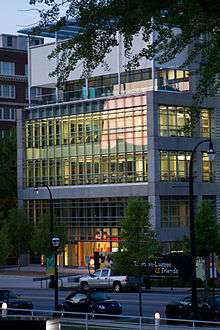
Atlanta is noted for its Southern culture. This is due to a large population of migrants from other parts of the U.S., in addition to many recent immigrants to the U.S. who have made the metropolitan area their home, establishing Atlanta as the cultural and economic hub of an increasingly multi-cultural metropolitan area.[143][144] Thus, although traditional Southern culture is part of Atlanta's cultural fabric, it is mostly the backdrop to one of the nation's most cosmopolitan cities. This unique cultural combination reveals itself in the arts district of Midtown, the quirky neighborhoods on the city's eastside, and the multi-ethnic enclaves found along Buford Highway.[145]
Arts and theater
Atlanta is one of few United States cities with permanent, professional, and resident companies in all major performing arts disciplines: opera (Atlanta Opera), ballet (Atlanta Ballet), orchestral music (Atlanta Symphony Orchestra), and theater (the Alliance Theatre). Atlanta attracts many touring Broadway acts, concerts, shows, and exhibitions catering to a variety of interests. Atlanta's performing arts district is concentrated in Midtown Atlanta at the Woodruff Arts Center, which is home to the Atlanta Symphony Orchestra and the Alliance Theatre. The city frequently hosts touring Broadway acts, especially at The Fox Theatre, a historic landmark among the highest-grossing theaters of its size.[146]
As a national center for the arts,[147] Atlanta is home to significant art museums and institutions. The renowned High Museum of Art is arguably the South's leading art museum and among the most-visited art museums in the world.[148] The Museum of Design Atlanta (MODA) and the SCAD FASH Museum of Fashion + Film are the only such museums in the Southeast.[149][150] Contemporary art museums include the Atlanta Contemporary Art Center and the Museum of Contemporary Art of Georgia. Institutions of higher education contribute to Atlanta's art scene, with the Savannah College of Art and Design's Atlanta campus providing the city's arts community with a steady stream of curators, and Emory University's Michael C. Carlos Museum containing the largest collection of ancient art in the Southeast.[151]
Atlanta has become one of the USA's best cities for street art in recent years.[152] It is home to Living Walls, an annual street art conference and the Outerspace Project, an annual event series that merges public art, live music, design, action sports, and culture. Examples of street art in Atlanta can be found on the Atlanta Street Art Map.[153]
Music and film
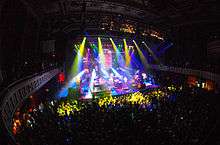
Atlanta has played a major or contributing role in the development of various genres of American music at different points in the city's history. Beginning as early as the 1920s, Atlanta emerged as a center for country music, which was brought to the city by migrants from Appalachia.[154] During the countercultural 1960s, Atlanta hosted the Atlanta International Pop Festival, with the 1969 festival taking place more than a month before Woodstock and featuring many of the same bands. The city was also a center for Southern rock during its 1970s heyday: the Allman Brothers Band's hit instrumental "Hot 'Lanta" is an ode to the city, while Lynyrd Skynyrd's famous live rendition of "Free Bird" was recorded at the Fox Theatre in 1976, with lead singer Ronnie Van Zant directing the band to "play it pretty for Atlanta".[155] During the 1980s, Atlanta had an active punk rock scene centered on two of the city's music venues, 688 Club and the Metroplex, and Atlanta famously played host to the Sex Pistols' first U.S. show, which was performed at the Great Southeastern Music Hall.[156] The 1990s saw the city produce major mainstream acts across many different musical genres. Country music artist Travis Tritt, and R&B sensations TLC, Usher and Toni Braxton, were just some of the musicians proud to call Atlanta home. The city also gave birth to Atlanta hip hop, a subgenre that gained relevance and success with the introduction of the home-grown ATLiens known as Outkast, along with other Dungeon Family artists such as Organized Noize and Goodie Mob; however, it was not until the 2000s that Atlanta moved "from the margins to becoming hip-hop's center of gravity with another sub-genre called Crunk, part of a larger shift in hip-hop innovation to the South and East".[157] Also in the 2000s, Atlanta was recognized by the Brooklyn-based Vice magazine for its indie rock scene, which revolves around the various live music venues found on the city's alternative eastside.[158][159] To facilitate further local development, the state government provides qualified businesses and productions a 15% transferable income tax credit for in-state costs of music investments.[160] Trap music became popular in Atlanta recently due to the success of 21 Savage, Future, Migos, Lil Yachty, 2 Chainz and Young Thug.[161][162]
As a national center for cinema and television production,[163] Atlanta plays a significant role in the entertainment industry. Atlanta is considered a hub for filmmakers of color and houses Tyler Perry's studios.[164] Atlanta doubles for other parts of the world and fictional settlements in blockbuster productions, among them the newer titles from The Fast and the Furious franchise and Marvel features such as Ant-Man (2015), Captain America: Civil War (2016), Black Panther and Avengers: Infinity War (both 2018).[165][166] On the other hand, Gone With the Wind (1939), Smokey and the Bandit (1977), Sharkey's Machine (1981), The Slugger's Wife (1985), Driving Miss Daisy (1989), ATL (2006), and Baby Driver (2017) are among several notable examples of films actually set in Atlanta.[167][168] The city also provides the backdrop for shows such as The Walking Dead, Stranger Things, The Vampire Diaries and Atlanta, in addition to a myriad of animated and reality television programming.[169][170]
Festivals
Atlanta has more festivals than any city in the southeastern United States.[171]
Some notable festivals in Atlanta include Shaky Knees Music Festival, Dragon Con, the Peachtree Road Race, Music Midtown, the Atlanta Film Festival, National Black Arts Festival, Festival Peachtree Latino, Atlanta Pride, the neighborhood festivals in Inman Park, Atkins Park, Virginia-Highland (Summerfest), and the Little Five Points Halloween festival.
Tourism
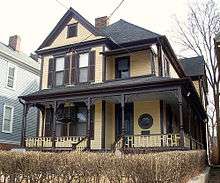
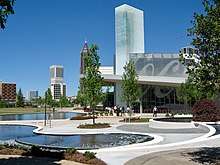
As of 2010, Atlanta is the seventh-most visited city in the United States, with over 35 million visitors per year.[172] Although the most popular attraction among visitors to Atlanta is the Georgia Aquarium,[173] the world's largest indoor aquarium,[174] Atlanta's tourism industry is mostly driven by the city's history museums and outdoor attractions. Atlanta contains a notable number of historical museums and sites, including the Martin Luther King Jr. National Historic Site, which includes the preserved childhood home of Dr. Martin Luther King Jr., as well as his final resting place; the Atlanta Cyclorama & Civil War Museum, which houses a massive painting and diorama in-the-round, with a rotating central audience platform, depicting the Battle of Atlanta in the Civil War; the World of Coca-Cola, featuring the history of the world-famous soft drink brand and its well-known advertising; the College Football Hall of Fame, which honors college football and its athletes; the National Center for Civil and Human Rights, which explores the civil rights movement and its connection to contemporary human rights movements throughout the world; the Carter Center and Presidential Library, housing U.S. President Jimmy Carter's papers and other material relating to the Carter administration and the Carter family's life; and the Margaret Mitchell House and Museum, where Mitchell wrote the best-selling novel Gone with the Wind.
Atlanta contains several outdoor attractions.[175] The Atlanta Botanical Garden, adjacent to Piedmont Park, is home to the 600-foot-long (180 m) Kendeda Canopy Walk, a skywalk that allows visitors to tour one of the city's last remaining urban forests from 40 feet (12 m) above the ground. The Canopy Walk is considered the only canopy-level pathway of its kind in the United States. Zoo Atlanta, in Grant Park, accommodates over 1,300 animals representing more than 220 species. Home to the nation's largest collections of gorillas and orangutans, the zoo is one of only four zoos in the U.S. to house giant pandas.[176] Festivals showcasing arts and crafts, film, and music, including the Atlanta Dogwood Festival, the Atlanta Film Festival, and Music Midtown, respectively, are also popular with tourists.[177]
Tourists are drawn to the city's culinary scene,[178] which comprises a mix of urban establishments garnering national attention, ethnic restaurants serving cuisine from every corner of the world, and traditional eateries specializing in Southern dining. Since the turn of the 21st century, Atlanta has emerged as a sophisticated restaurant town.[179] Many restaurants opened in the city's gentrifying neighborhoods have received praise at the national level, including Bocado, Bacchanalia, and Miller Union in West Midtown, Empire State South in Midtown, and Two Urban Licks and Rathbun's on the east side.[57][180][181][182] In 2011, The New York Times characterized Empire State South and Miller Union as reflecting "a new kind of sophisticated Southern sensibility centered on the farm but experienced in the city."[183] Visitors seeking to sample international Atlanta are directed to Buford Highway, the city's international corridor, and suburban Gwinnett County. There, the nearly-million immigrants that make Atlanta home have established various authentic ethnic restaurants representing virtually every nationality on the globe.[184][185] For traditional Southern fare, one of the city's most famous establishments is The Varsity, a long-lived fast food chain and the world's largest drive-in restaurant.[186] Mary Mac's Tea Room and Paschal's are more formal destinations for Southern food. Soul food is popular in Atlanta amongst African Americans.
Sports
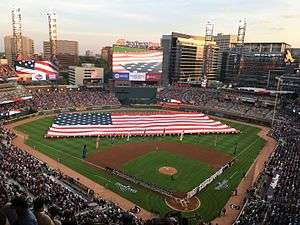
Atlanta is home to professional franchises for four major team sports: the Atlanta Braves of Major League Baseball, the Atlanta Hawks of the National Basketball Association, the Atlanta Falcons of the National Football League, and Atlanta United FC of Major League Soccer. The Braves, who moved to Atlanta in 1966, were established as the Boston Red Stockings in 1871 and are the oldest continually operating professional sports franchise in the United States.[187] The Braves won the World Series in 1995, and had an unprecedented run of 14 straight divisional championships from 1991 to 2005.[188] The Braves have a new home as of 2017, having moved from Turner Field to Truist Park, which is in the Atlanta Metropolitan area 10 miles (16 km) northwest of downtown Atlanta in Cumberland/Galleria, Georgia.
The Atlanta Falcons have played in Atlanta since their inception in 1966. The team played their home games originally at Atlanta-Fulton County Stadium, followed by the Georgia Dome and currently at Mercedes Benz Stadium.The Falcons have won the division title six times (1980, 1998, 2004, 2010, 2012, 2016) and the NFC championship twice in 1998 and 2016. However, they have been unsuccessful in both of their Super Bowl trips so far, losing to the Denver Broncos in Super Bowl XXXIII in 1999 and to the New England Patriots in Super Bowl LI in 2017.[189] The Atlanta Hawks began in 1946 as the Tri-Cities Blackhawks, playing in Moline, Illinois. The team moved to Atlanta in 1968 and plays its games in State Farm Arena.[190] The Atlanta Dream is the city's Women's National Basketball Association franchise.[191]
Professional soccer has been played in some form in Atlanta since 1967. Atlanta's first professional soccer team was the Atlanta Chiefs of the original North American Soccer League which won the 1968 NASL Championship and defeated English first division club Manchester City F.C. twice in international friendlies. In 1998 another professional soccer team was formed, the Atlanta Silverbacks of the new North American Soccer League, which now plays as an amateur club in the National Premier Soccer League. In 2014, Atlanta Falcons owner Arthur Blank founded Atlanta United FC as Atlanta's first premier-division professional soccer club since the Chiefs.[192] Atlanta United has broken the MLS single-game attendance record in both the regular season and the playoffs, the single-game attendance record of the U.S. Open Cup, the all-time record for highest season average attendance of any first division club in the United States, and the highest attendance record for an MLS Cup game. Atlanta United won MLS Cup 2018 on December 8, 2018, defeating the Portland Timbers 2–0 at Mercedes Benz Stadium. The club is estimated by Forbes to be the most valuable club in Major League Soccer.[193]
Atlanta has had its own professional ice hockey franchises, both of which relocated after playing in Atlanta for fewer than 15 years. The National Hockey League (NHL) has had two Atlanta franchises: the Atlanta Flames began play in 1972 before moving to Calgary in 1980, while the Atlanta Thrashers began play in 1999 before moving to Winnipeg in 2011. In 2019, Atlanta also had an Alliance of American Football team, the Atlanta Legends, but the league was suspended part way through its first season and the team folded.
On September 21, 2018, Major League Rugby announced that Atlanta was one of the expansion teams joining the league for the 2020 season[194] named Rugby ATL.[195] On August 2, 2018, it was announced that Atlanta would have its own Overwatch League team, Atlanta Reign.
Atlanta has been the host city for various international, professional and collegiate sporting events, most famously the Centennial 1996 Summer Olympics. Atlanta hosted Super Bowl XXVIII in 1994, Super Bowl XXXIV in 2000, and Super Bowl LIII in 2019.[196] In professional golf, The Tour Championship, the final PGA Tour event of the season, is played annually at East Lake Golf Club. In 2001 and 2011, Atlanta hosted the PGA Championship, one of the four major championships in men's professional golf, at the Atlanta Athletic Club. In professional ice hockey, the city hosted the 56th NHL All-Star Game in 2008, three years before the Thrashers moved. In 2011, Atlanta hosted professional wrestling's annual WrestleMania. The city has hosted the NCAA Final Four Men's Basketball Championship four times, most recently in 2013. In college football, Atlanta hosts the Chick-fil-A Kickoff Game, the SEC Championship Game, the Celebration Bowl, the MEAC/SWAC Challenge, and the Chick-fil-A Peach Bowl.[197]
Running is a popular local sport, and the city declares itself to be "Running City USA".[198] The city hosts the Peachtree Road Race, the world's largest 10 km race, annually on Independence Day.[199] Atlanta also hosts the nation's largest Thanksgiving day half marathon, which starts and ends at Georgia State Stadium.[200] The Atlanta Marathon, which starts and ends at Centennial Olympic Park, routes through many of the city's historic landmarks,[201] and its 2020 running will coincide with the U.S. Olympic marathon trials for the 2020 Summer Olympics.[202]
Parks and recreation

Atlanta's 343 parks, nature preserves, and gardens cover 3,622 acres (14.66 km2),[203] which amounts to only 5.6% of the city's total acreage, compared to the national average of just over 10%.[204][205] However, 64% of Atlantans live within a 10-minute walk of a park, a percentage equal to the national average.[206] In its 2013 ParkScore ranking, The Trust for Public Land reported that among the park systems of the 50 most populous U.S. cities, Atlanta's park system received a ranking of 31.[207] Piedmont Park, in Midtown, is Atlanta's most iconic green space. The park, which underwent a major renovation and expansion in recent years, attracts visitors from across the region and hosts cultural events throughout the year. Other notable city parks include Centennial Olympic Park, a legacy of the 1996 Summer Olympics that forms the centerpiece of the city's tourist district; Woodruff Park, which anchors the campus of Georgia State University; Grant Park, home to Zoo Atlanta; Chastain Park, which houses an amphitheater used for live music concerts; and the under construction Westside Park at Bellwood Quarry, the 280-acre green space and reservoir project slated to become the city's largest park when fully complete in the 2020s.[208] The Chattahoochee River National Recreation Area, in the northwestern corner of the city, preserves a 48 mi (77 km) stretch of the river for public recreation opportunities.

The Atlanta Botanical Garden, adjacent to Piedmont Park, contains formal gardens, including a Japanese garden and a rose garden, woodland areas, and a conservatory that includes indoor exhibits of plants from tropical rainforests and deserts. The BeltLine, a former rail corridor that forms a 22 mi (35 km) loop around Atlanta's core, has been transformed into a series of parks, connected by a multi-use trail, increasing Atlanta's park space by 40%.[209]
Atlanta offers resources and opportunities for amateur and participatory sports and recreation. Golf and tennis are popular in Atlanta, and the city contains six public golf courses and 182 tennis courts. Facilities along the Chattahoochee River cater to watersports enthusiasts, providing the opportunity for kayaking, canoeing, fishing, boating, or tubing. The city's only skate park, a 15,000 square feet (1,400 m2) facility that offers bowls, curbs, and smooth-rolling concrete mounds, is at Historic Fourth Ward Park.[210]
Government
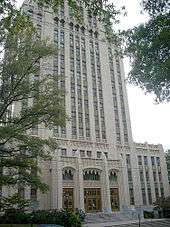
Atlanta is governed by a mayor and the Atlanta City Council. The city council consists of 15 representatives—one from each of the city's 12 districts and three at-large positions. The mayor may veto a bill passed by the council, but the council can override the veto with a two-thirds majority.[211] The mayor of Atlanta is Keisha Lance Bottoms, a Democrat elected on a nonpartisan ballot whose first term in office began on January 2, 2018.[212] Every mayor elected since 1973 has been black.[213] In 2001, Shirley Franklin became the first woman to be elected mayor of Atlanta, and the first African-American woman to serve as mayor of a major Southern city.[214] Atlanta city politics suffered from a notorious reputation for corruption during the 1990s administration of Mayor Bill Campbell, who was convicted by a federal jury in 2006 on three counts of tax evasion in connection with gambling winnings during trips he took with city contractors.[215]
As the state capital, Atlanta is the site of most of Georgia's state government. The Georgia State Capitol building, located downtown, houses the offices of the governor, lieutenant governor and secretary of state, as well as the General Assembly. The Governor's Mansion is in a residential section of Buckhead. Atlanta serves as the regional hub for many arms of the federal bureaucracy, including the Federal Reserve Bank of Atlanta and the Centers for Disease Control and Prevention (CDC).[216][217] The City of Atlanta annexed the CDC into its territory effective January 1, 2018.[218] Atlanta also plays an important role in the federal judiciary system, containing the United States Court of Appeals for the Eleventh Circuit and the United States District Court for the Northern District of Georgia.
Historically, Atlanta has been a stronghold for the Democratic Party. Although municipal elections are officially nonpartisan, nearly all of the city's elected officials are registered Democrats. The city is split among 14 state house districts and four state senate districts, all held by Democrats. At the federal level, Atlanta is split between two congressional districts. Most of the city is in the 5th district, represented by Democrat John Lewis. A small portion in the north is in the 11th district, represented by Republican Barry Loudermilk.
Law enforcement, fire, and EMS services
The city is served by the Atlanta Police Department, which numbers 2,000 officers[219] and oversaw a 40% decrease in the city's crime rate between 2001 and 2009. Specifically, homicide decreased by 57%, rape by 72%, and violent crime overall by 55%. Crime is down across the country, but Atlanta's improvement has occurred at more than twice the national rate.[220] Nevertheless, Forbes ranked Atlanta as the sixth most dangerous city in the United States in 2012.[221] Aggravated assaults, burglaries and robberies were down from 2014.[222] Mexican drug cartels thrive in Atlanta.[223] 145 gangs operate in Atlanta.[224]
The Atlanta Fire Rescue Department provides fire protection and first responder emergency medical services to the city from its 35 fire stations. In 2017, AFRD responded to over 100,000 calls for service over a coverage area of 135.7 square miles (351.5 square kilometres). The department also protects Hartsfield–Jackson with 5 fire stations on the property; serving over 1 million passengers from over 100 different countries. The department protects over 3000 highrise buildings, 23 miles (37 kilometres) of the rapid rail system, and 60 miles (97 kilometres) of interstate highway.[225]
Emergency ambulance services are provided to city residents by hospital based Grady EMS (Fulton County),[226] and American Medical Response (DeKalb County).[227]
Atlanta in January 2017 declared the city was a "welcoming city" and "will remain open and welcoming to all". Nonetheless, Atlanta does not consider itself to be a "sanctuary city".[228] Atlanta Mayor Keisha Lance Bottoms said: "Our city does not support ICE. We don't have a relationship with the U.S. Marshal[s] Service. We closed our detention center to ICE detainees, and we would not pick up people on an immigration violation."[229]
Education
Tertiary education
Due to more than 15 colleges and universities in Atlanta, it is considered one of the nation's largest hubs for higher education.[230][231]
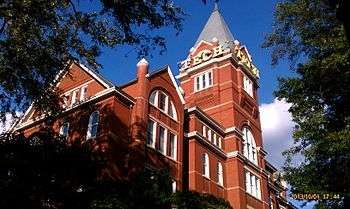
The Georgia Institute of Technology is a prominent public research university in Midtown. It offers highly ranked degree programs in engineering, design, industrial management, the sciences, and architecture.
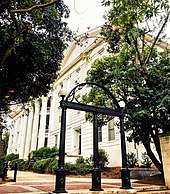
The University of Georgia, chartered in 1785, is one of the top public research universities in the nation with "Highest Research Activity" and is based about an hour away in Athens, Georgia; however, the Atlanta Center of its Terry College of Business is in the Buckhead area of Atlanta and the university has a metropolitan Atlanta Gwinnett Campus that occupies 60,000 square feet of the Intellicenter.
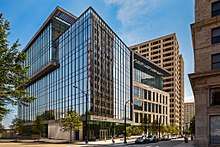
Georgia State University is a major public research university in Downtown Atlanta; it is the largest of the 29 public colleges and universities in the University System of Georgia and is a significant contributor to the revitalization of the city's central business district.
Atlanta is home to nationally renowned private colleges and universities, most notably Emory University, a leading liberal arts and research institution that consistently ranks among the top 25 universities in the United States and operates Emory Healthcare, the largest health care system in Georgia. [232] The City of Atlanta annexed Emory into its territory effective January 1, 2018.[218]
The Atlanta University Center is also in the city; it is the largest contiguous consortium of historically black colleges in the nation, comprising Spelman College, Clark Atlanta University, Morehouse College, and Morehouse School of Medicine. Atlanta contains a campus of the Savannah College of Art and Design, a private art and design university that has proven to be a major factor in the recent growth of Atlanta's visual art community. Atlanta and nearby Athens also boast American Bar Association accredited law schools: Atlanta's John Marshall Law School, Emory University School of Law, Georgia State University College of Law and University of Georgia School of Law.
The Atlanta Regional Council of Higher Education (ARCHE) is dedicated to strengthening synergy among 19 public and private colleges and universities in the Atlanta region. Participating Atlanta region colleges and universities partner on joint-degree programs, cross-registration, library services, and cultural events.[233]
Primary and secondary education
Fifty-five thousand students are enrolled in 106 schools in Atlanta Public Schools (APS), some of which are operated as charter schools.[234] Atlanta is served by many private schools including, without limitation, Atlanta Jewish Academy, Atlanta International School, The Westminster Schools, Pace Academy, The Lovett School, The Paideia School, Holy Innocents' Episcopal School and Roman Catholic parochial schools operated by the Archdiocese of Atlanta.
In 2018 the City of Atlanta annexed a portion of DeKalb County containing the Centers for Disease Control and Emory University; this portion will be zoned to the DeKalb County School District until 2024, when it will transition into APS.[235]
Media
The primary network-affiliated television stations in Atlanta are WXIA-TV 11 (NBC), WGCL-TV 46 (CBS), WSB-TV 2 (ABC), and WAGA-TV 5 (Fox). Other major commercial stations include WPXA-TV 14 (Ion), WPCH-TV 17 (Ind.), WUVG-TV 34 (Univision), WUPA 69 (CW), and WATL 36 (MyNetworkTV). WPXA-TV, WUVG-TV, WAGA-TV and WUPA are network O&O's. The Atlanta metropolitan area is served by two public television stations (both PBS member stations), and two public radio stations. WGTV 8 is the flagship station of the statewide Georgia Public Television network, while WPBA is owned by Atlanta Public Schools. Georgia Public Radio is listener-funded and comprises one NPR member station, WABE, a classical music station operated by Atlanta Public Schools. The second public radio, listerner-funded NPR member station is WCLK, a jazz music station owned and operated by Clark Atlanta University.
Atlanta is served by the Atlanta Journal-Constitution, its only major daily newspaper with wide distribution. The Atlanta Journal-Constitution is the result of a 1950 merger between The Atlanta Journal and The Atlanta Constitution, with staff consolidation occurring in 1982 and separate publication of the morning Constitution and afternoon Journal ceasing in 2001.[236] Alternative weekly newspapers include Creative Loafing, which has a weekly print circulation of 80,000. Atlanta magazine is an award-winning, monthly general-interest magazine based in and covering Atlanta.
Transportation
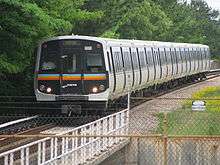
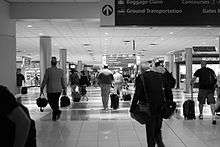

Atlanta's transportation infrastructure comprises a complex network that includes a heavy rail rapid transit system, a light rail streetcar loop, a multi-county bus system, Amtrak service via the Crescent, multiple freight train lines, an Interstate Highway System, several airports, including the world's busiest, and over 45 miles (72 kilometres) of bike paths.
Atlanta has a network of freeways that radiate out from the city, and automobiles are the dominant means of transportation in the region.[237] Three major interstate highways converge in Atlanta: I-20 (east-west), I-75 (northwest-southeast), and I-85 (northeast-southwest). The latter two combine in the middle of the city to form the Downtown Connector (I-75/85), which carries more than 340,000 vehicles per day and is one of the most congested segments of interstate highway in the United States.[238] Atlanta is mostly encircled by Interstate 285, a beltway locally known as "the Perimeter" that has come to mark the boundary between "Inside the Perimeter" (ITP), the city and close-in suburbs, and "Outside the Perimeter" (OTP), the outer suburbs and exurbs. The heavy reliance on automobiles for transportation in Atlanta has resulted in traffic, commute, and air pollution rates that rank among the worst in the country.[239][240][241] The City of Atlanta has a higher than average percentage of households without a car. In 2015, 15.2 percent of Atlanta households lacked a car, and increased slightly to 16.4 percent in 2016. The national average is 8.7 percent in 2016. Atlanta averaged 1.31 cars per household in 2016, compared to a national average of 1.8.[242]
The Metropolitan Atlanta Rapid Transit Authority (MARTA) provides public transportation in the form of buses, heavy rail, and a downtown light rail loop. Notwithstanding heavy automotive usage in Atlanta, the city's subway system is the eighth busiest in the country.[243] MARTA rail lines connect key destinations, such as the airport, Downtown, Midtown, Buckhead, and Perimeter Center. However, significant destinations, such as Emory University and Cumberland, remain unserved. As a result, a 2011 Brookings Institution study placed Atlanta 91st of 100 metro areas for transit accessibility.[244] Emory University operates its Cliff shuttle buses with 200,000 boardings per month, while private minibuses supply Buford Highway. Amtrak, the national rail passenger system, provides service to Atlanta via the Crescent train (New York–New Orleans), which stops at Peachtree Station. In 2014, the Atlanta Streetcar opened to the public. The streetcar's line, which is also known as the Downtown Loop, runs 2.7 miles (4.3 kilometres) around the downtown tourist areas of Peachtree Center, Centennial Olympic Park, the Martin Luther King, Jr. National Historic Site, and Sweet Auburn.[245] The Atlanta Streetcar line is also being expanded on in the coming years to include a wider range of Atlanta's neighborhoods and important places of interest, with a total of over 50 miles (80 kilometres) of track in the plan.[246]
Hartsfield–Jackson Atlanta International Airport is the world's busiest airport as measured by passenger traffic and aircraft traffic.[247] The facility offers air service to over 150 U.S. destinations and more than 75 international destinations in 50 countries, with over 2,500 arrivals and departures daily.[248] Delta Air Lines maintains its largest hub at the airport.[249] Situated 10 miles (16 km) south of downtown, the airport covers most of the land inside a wedge formed by Interstate 75, Interstate 85, and Interstate 285.
Cycling is a growing mode of transportation in Atlanta, more than doubling since 2009, when it comprised 1.1% of all commutes (up from 0.3% in 2000).[250][251] Although Atlanta's lack of bike lanes and hilly topography may deter many residents from cycling,[250][252] the city's transportation plan calls for the construction of 226 miles (364 kilometres) of bike lanes by 2020, with the BeltLine helping to achieve this goal.[253] In 2012, Atlanta's first "bike track" was constructed on 10th Street in Midtown. The two lane bike track runs from Monroe Drive west to Charles Allen Drive, with connections to the Beltline and Piedmont Park.[254] Starting in June 2016, Atlanta received a bike sharing program, known as Relay Bike Share, with 100 bikes in Downtown and Midtown, which expanded to 500 bikes at 65 stations as of April 2017.[255][256]
According to the 2016 American Community Survey (five-year average), 68.6% of working city of Atlanta residents commuted by driving alone, 7% carpooled, 10% used public transportation, and 4.6% walked. About 2.1% used all other forms of transportation, including taxi, bicycle, and motorcycle. About 7.6% worked at home.[257]
The city has also become one of a handful of "scooter capitals," where companies like Lime[258] and Bird[259][260] have gained a major foothold by placing electric scooters on street corners and byways.
Tree canopy
—National Geographic magazine, in naming Atlanta a "Place of a Lifetime"[261]
Atlanta has a reputation as a "city in a forest" due to an abundance of trees that is rare among major cities.[262][263][264] The city's main street is named after a tree, and beyond the Downtown, Midtown, and Buckhead business districts, the skyline gives way to a dense canopy of woods that spreads into the suburbs. The city is home to the Atlanta Dogwood Festival, an annual arts and crafts festival held one weekend during early April, when the native dogwoods are in bloom. The nickname is factually accurate, as vegetation covers 47.9% of the city as of 2017,[265] the highest among all major American cities, and well above the national average of 27%.[266] Atlanta's tree coverage does not go unnoticed—it was the main reason cited by National Geographic in naming Atlanta a "Place of a Lifetime".[261][267]
The city's lush tree canopy, which filters out pollutants and cools sidewalks and buildings, has increasingly been under assault from man and nature due to heavy rains, drought, aged forests, new pests, and urban construction. A 2001 study found Atlanta's heavy tree cover declined from 48% in 1974 to 38% in 1996.[268] Community organizations and the city government are addressing the problem. Trees Atlanta, a non-profit organization founded in 1985, has planted and distributed over 113,000 shade trees in the city,[269] and Atlanta's government has awarded $130,000 in grants to neighborhood groups to plant trees.[263] Fees are additionally imposed on developers that remove trees on their property per a citywide ordinance, active since 1993.[270]
International relations
Atlanta has 17 sister cities, as designated by Sister Cities International, Inc. (SCI):[271][272][273]
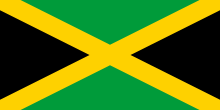






.svg.png)









See also
- List of people from Atlanta
- Urban forest
Notes
- The term "Atlantans" is widely used by both local media and national media.
- Mean monthly maxima and minima (i.e. the highest and lowest temperature readings during an entire month or year) calculated based on data at said location from 1981 to 2010.
- Official records for Atlanta were kept at the Weather Bureau in downtown from October 1878 to August 1928, and at Hartsfield–Jackson Int'l since September 1928.[91]
References
- "2018 U.S. Gazetteer Files". United States Census Bureau. Retrieved February 12, 2020.
- "Population and Housing Unit Estimates". Retrieved June 4, 2019.
- "Annual Estimates of the Resident Population: April 1, 2010 to July 1, 2018". United States Census Bureau, Population Division. April 2019. Archived from the original on February 13, 2020. Retrieved May 30, 2019.
- "Annual Estimates of the Resident Population: April 1, 2010 to July 1, 2018 – United States – Combined Statistical Area; and for Puerto Rico". United States Census Bureau, Population Division. March 2018. Retrieved May 8, 2019.
- "U.S. Census website". United States Census Bureau. Retrieved January 31, 2008.
- "US Board on Geographic Names". United States Geological Survey. October 25, 2007. Retrieved January 31, 2008.
- "Annual Estimates of the Resident Population for Incorporated Places of 50,000 or More, Ranked by July 1, 2018 Population: April 1, 2010 to July 1, 2018". United States Census Bureau, Population Division. Archived from the original on February 13, 2020. Retrieved May 23, 2019.
- "'Altitudes of Major US Cities', Red Oaks Trading, Ltd". Archived from the original on December 11, 2013. Retrieved October 28, 2014.
- "Atlanta". New Georgia Encyclopedia.
- ""Who's right? Cities lay claim to civil rights 'cradle' mantle"/'"Atlanta Journal-Constitution". Politifact.com. June 28, 2011. Retrieved May 17, 2012.
- Hinz, Greg (January 26, 2017). "World's busiest airport title slips further from O'Hare's grasp". Crain's Chicago Business. Retrieved February 14, 2017.
- "DOT: Hartsfield-Jackson busiest airport, Delta had 3rd-most passengers". March 13, 2008.
- "Top Industry Publications Rank Atlanta as a LeadingCity for Business". AllBusiness.com. Archived from the original on April 19, 2009. Retrieved April 5, 2010.
- "Doing Business in Atlanta, Georgia". Business.gov. Archived from the original on April 2, 2010. Retrieved April 5, 2010.
- "Global city GDP 2014". Brookings Institution. Retrieved May 8, 2015.
- "Gross Domestic Product by Metropolitan Area, 2017" (PDF). Bureau of Economic Analysis. September 20, 2018. Retrieved September 2, 2018.
- "Atlanta: Economy – Major Industries and Commercial Activity". City-data.com. Retrieved July 16, 2012.
- Gournay, Isabelle (1993). AIA Guide to the Architecture of Atlanta. University of Georgia Press. ISBN 0820314390.
- "IDEALS @ Illinois: Governmentality: the new urbanism and the creative class within Atlanta, Georgia". May 22, 2012. hdl:2142/31169. Cite journal requires
|journal=(help) - Pooley, Karen Beck (April 15, 2015). "Segregation's New Geography: The Atlanta Metro Region, Race, and the Declining Prospects for Upward Mobility". Southern Spaces. doi:10.18737/M74S47. Retrieved May 26, 2015.
- Felton, Carly. A Marmac Guide to Atlanta. ISBN 9781455608461.
- "Creation of the Western and Atlantic Railroad". About North Georgia. Golden Ink. Retrieved November 12, 2007.
- "Thrasherville". Georgia Info. Retrieved February 6, 2017.
- Ambrose, Andy. "Atlanta". New Georgia Encyclopedia. Georgia Humanities Council. Retrieved February 6, 2017.
- "Georgia History Timeline Chronology for December 29". Our Georgia History. Retrieved August 30, 2007.
- Storey, Steve. "Atlanta & West Point Railroad". Georgia's Railroad History & Heritage. Retrieved September 28, 2007.
- "Atlanta Old and New: 1848 to 1868". Roadside Georgia. Golden Ink. Retrieved November 13, 2007.
- "Chronology of Sherman's March to the sea, the Carolina's Campaign, and Its Aftermath".
- Jackson, Edwin L. "The Story of Georgia's Capitols and Capital Cities". Carl Vinson Institute of Government, University of Georgia. Archived from the original on October 9, 2007. Retrieved November 13, 2007.
- "The South: Vast Resources, Rapid Development, Wonderful Opportunities for Capital and Labor ..." (PDF). The New York Times. June 8, 1895.
- "The Jewish Community of Atlanta". Beit Hatfutsot Open Databases Project. The Museum of the Jewish People at Beit Hatfutsot.
- Klapper, Melissa, R., PhD. "20th-Century Jewish Immigration". Teachinghistory.org, accessed February 6, 2012.
- "Atlanta Premiere of Gone with the Wind". Ngeorgia.com. Retrieved April 5, 2010.
- Kevin Michael Kruse (February 1, 2008). White Flight: Atlanta and the Making of Modern Conservatism. Princeton University Press. ISBN 978-0-691-09260-7.
- ""The South: Divided City", Time magazine, January 18, 1961". TIME. January 18, 1963. Retrieved June 27, 2011.
- Hatfield, Edward. "Bus Desegregation in Atlanta". New Georgia Encyclopedia. Georgia Humanities Council. Retrieved February 6, 2017.
- "Rich's Department Store". New Georgia Encyclopedia.
- "Negroes Attend Atlanta Theaters". Atlanta Journal. May 15, 1962.
- "APS Timeline". Atlanta Regional Council for Higher Education. Archived from the original on January 13, 2016. Retrieved February 5, 2016.
- Lillie, Karen (June 10, 2019). "Transforming the elite: black students and the desegregation of private schools, by Michelle A. Purdy". History of Education: 1–2. doi:10.1080/0046760X.2019.1622794. ISSN 0046-760X.
- "Race and Hispanic Origin for Selected Cities and Other Places: Earliest Census to 1990". U.S. Census Bureau. Archived from the original on August 12, 2012. Retrieved January 2, 2012.
- "Campus Development". gwcca.org. Georgia World Congress Center Authority. Retrieved February 6, 2017.
- "History of MARTA – 1970–1979". Metropolitan Atlanta Rapid Transit Authority. Archived from the original on February 4, 2005. Retrieved March 2, 2008.
- "Do Olympic Host Cities Ever Win? - NYTimes.com". Roomfordebate.blogs.nytimes.com. October 2, 2009. Retrieved July 16, 2012.
- "Olympic Games Atlanta, Georgia, U.S., 1996". Encyclopædia Britannica online. Encyclopædia Britannica. Retrieved January 2, 2008.
- Tiffany Davis, B.A. (January 22, 2009). "The U.S. Census in the Past and Present" (PDF). Spelman College. Archived from the original (PDF) on December 8, 2011.
- Galloway, Jim (March 23, 2011). "A census speeds Atlanta toward racially neutral ground". The Atlanta Journal-Constitution. Archived from the original on September 13, 2014. Retrieved July 16, 2012.
- Dewan, Shaila (March 11, 2006). "Gentrification Changing Face of New Atlanta". The New York Times.
- "Urban centers draw more young, educated adults". USA Today. April 1, 2011.
- Schneider, Craig (April 13, 2011). "Young professionals lead surge of intown living". ajc.com. Retrieved June 27, 2011.
- Trubey, J. Scott (August 6, 2018). "Ex-Atlanta Housing Authority chief Glover sues agency for legal fees". Atlanta Journal Constitution. Retrieved August 29, 2019.
- Deirdre Oakley; Erin Ruel; G. Elton Wilson. "A Choice with No Options: Atlanta Public Housing Residents' Lived Experiences in the Face of Relocation" (PDF). Georgia State University. Archived from the original (PDF) on December 18, 2014.
- Husock, Howard. "Reinventing Public Housing: Is the Atlanta Model Right for Your City?" (PDF). Manhattan Institute for Policy Research. Archived from the original (PDF) on April 26, 2012. Retrieved July 16, 2012.
- US Census Bureau 1990 census – total number of housing units in Atlanta city
- Husock, Howard (Autumn 2010). "Atlanta's Public-Housing Revolution". City Journal. Retrieved July 16, 2012.
- "The Atlanta BeltLine in 5". Atlanta Beltline. Atlanta Beltline Inc. Archived from the original on February 7, 2017. Retrieved February 6, 2017.
- Martin, Timothy W. (April 16, 2011). "The New New South". The Wall Street Journal.
- Perlroth, Nicole; Benner, Katie (November 28, 2018). "Iranians Accused in Cyberattacks, Including One That Hobbled Atlanta". The New York Times.
- "Geographic Identifiers: 2010 Demographic Profile Data (G001): Atlanta city, Georgia". U.S. Census Bureau, American Factfinder. Retrieved October 21, 2015.
- "'Altitudes of Major US Cities', Red Oaks Trading, Ltd". Archived from the original on December 11, 2013. Retrieved October 28, 2014.
- Yeazel, Jack (March 23, 2007). "Eastern Continental Divide in Georgia". Retrieved July 5, 2007.
- "Florida, Alabama, Georgia water sharing". WaterWebster. Archived from the original (news archive) on June 24, 2007. Retrieved July 5, 2007.
- Gournay, Isabelle (1993). AIA Guide to the Architecture of Atlanta. University of Georgia Press. ISBN 0820314501.
- "The Westin Peachtree Plaza, Atlanta". CrediFi. Retrieved October 16, 2016.
- "One Atlantic Center". CrediFi. Retrieved October 16, 2016.
- "World's Tallest Buildings". Infoplease. Retrieved June 26, 2007.
- "Atlanta Neighborhoods". City of Atlanta Online. Archived from the original on July 16, 2011. Retrieved June 27, 2011.
- ""Neighborhoods", Central Atlanta Progress". Retrieved October 28, 2014.
- "MIDTOWN ATLANTA: NEIGHBORHOODS". October 13, 2007. Archived from the original on October 13, 2007.
- "Districts and Zones of Atlanta". Emporis.com. Archived from the original on June 2, 2004. Retrieved June 26, 2007.
- Joseph F. Thompson; Robert Isbell (1994). Atlanta: A City of Neighborhoods. University of South Carolina Press. ISBN 978-0-87249-979-9.
- Southerland, Randy (November 19, 2004). "What do Atlanta's big law firms see in Midtown?". Atlanta Business Chronicle. Retrieved December 1, 2008.
- Kirby, David (November 2, 2003). "A Tab of Two Cities: Atlanta, Old And New". The New York Times. Retrieved July 16, 2012.
- [AIA guide to the architecture of Atlanta, edited by Gerald W. Sams, University of Georgia Press, 1993, p. 195]
- Greenfield, Beth (May 29, 2005). "SURFACING – EAST ATLANTA – The Signs of Chic Are Emerging – NYTimes.com". The New York Times. Atlanta (Ga); Georgia. Retrieved October 16, 2012.
- Dewan, Shaila (November 19, 2009). "An Upstart Art Scene, on Atlanta's West Side – NYTimes.com". Atlanta (Ga): Travel.nytimes.com. Retrieved July 16, 2012.
- Stirgus, Eric; Torpy, Bill (November 1, 2009). "Atlanta mayor's race: Words of support". Atlanta Journal-Constitution. Archived from the original on February 2, 2012. Retrieved October 28, 2014.
- "The Black Middle Class: Where It Lives", Ebony, August 1987. Johnson Publishing Company. August 1987. Retrieved October 28, 2014.
- "Atlanta's minorities see dramatic rise in homeownership". Chicago Tribune. June 27, 2004. Retrieved October 28, 2014.
- Wheatley, Thomas (December 15, 2010). "Wal-Mart and Prince Charles give Vine City a boost". Creative Loafing. Retrieved July 16, 2012.
- Powers, Benjamin (November 10, 2017). "Putting the Brakes on Runaway Gentrification in Atlanta". CityLab. Retrieved September 28, 2018.
- "Impact of Climate Change on Buildings". ResearchGate. Retrieved December 2, 2018.
- "Climate of the Southeast of the United States" (PDF). National Climate Assessment Regional Technical Input Report Series.
- Atlanta, Georgia Travel Weather Averages. Weatherbase. Retrieved on July 12, 2013.
- Dorish, Joe (May 1, 2013). "All-time Record Hottest and Coldest Temperatures Ever Recorded in Atlanta". voices.yahoo.com. Archived from the original on August 23, 2013. Retrieved June 10, 2013.
- "NowData – NOAA Online Weather Data". National Oceanic and Atmospheric Administration. Retrieved November 30, 2012.
- "Monthly Averages for Atlanta, Georgia (30303)" (Table). Weather Channel. Retrieved March 23, 2008.
- "View Maps – USDA Plant Hardiness Zone Map". planthardiness.ars.usda.gov. Retrieved June 28, 2019.
- "Average Total Snowfall (inches) for Selected Cities in the Southeast | Welcome – Southeast Regional Climate Center". Sercc.com. Retrieved June 10, 2013.
- "Atlanta, Georgia (1900–2000)". Our Georgia History. Retrieved April 2, 2006.
- ThreadEx
- "Station Name: GA ATLANTA HARTSFIELD INTL AP". National Oceanic and Atmospheric Administration. Retrieved March 19, 2013.
- "NowData – NOAA Online Weather Data". National Oceanic and Atmospheric Administration. Retrieved April 12, 2016.
- "WMO Climatological Normals of Atlanta/Hartsfield INTL AP, GA". National Oceanic and Atmospheric Administration. Retrieved October 31, 2013.
- "Atlanta, Georgia, USA – Monthly weather forecast and Climate data". Weather Atlas. Retrieved January 23, 2019.
- "Atlanta (city), Georgia". State & County QuickFacts. U.S. Census Bureau. Archived from the original on February 14, 2020. Retrieved December 23, 2015.
- "Profile of General Population and Housing Characteristics: 2010" (Select Atlanta (city), Georgia)". US Census Bureau. Archived from the original on December 18, 2012. Retrieved October 28, 2014.
- Gary J. Gates (October 2006). "Same-sex Couples and the Gay, Lesbian, Bisexual Population: New Estimates from the American Community Survey" (PDF). The Williams Institute. The Williams Institute. Archived from the original (PDF) on June 9, 2013. Retrieved June 30, 2013.
- https://www.latimes.com/archives/la-xpm-2004-may-24-me-migration24-story.html
- https://lawrencemigration.phillipscollection.org/culture/migration-map
- "A CHAMPION FOR ATLANTA: Maynard Jackson: 'Black mecca' burgeoned under leader", Atlanta Journal-Constitution, June 29, 2003
- "the city that calls itself America's 'Black Mecca'" in "Atlanta Is Less Than Festive on Eve of Another 'Freaknik'", Washington Post, April 18, 1996
- "Atlanta emerges as a center of black entertainment", New York Times, November 26, 2011
- Gurwitt, Rob (July 1, 2008). "Atlanta and the Urban Future". Governing Magazine. Governing.com. Retrieved February 2, 2017.
- U.S. Census 2008 American Community Survey
- Pillsbury, Richard (February 2014). The New Encyclopedia of Southern Culture: Volume 2: Geography. ISBN 9780807877210.
- "Tongue Twisters", Atlanta magazine. Emmis Communications. December 2003. Retrieved May 17, 2012.
- "Too Southern for Atlanta", Atlanta magazine. Emmis Communications. February 2003. Retrieved May 17, 2012.
- Bonesteel, Amy (November 1, 2012). "Is There an Atlanta Accent?". Atlanta Magazine. Retrieved July 31, 2017.
- Major U.S. metropolitan areas differ in their religious profiles, Pew Research Center
- "America's Changing Religious Landscape". Pew Research Center: Religion & Public Life. May 12, 2015.
- "Atlanta, Ga". Information Please Database. Pearson Education, Inc. Retrieved May 17, 2006.
- https://www.asanet.org/sites/default/files/savvy/footnotes/mayjun10/am_050610.html
- Frazier, John W.; Darden, Joe T.; Henry, Norah F. (September 2010). African Diaspora in the United States and Canada at the Dawn of the 21st Century, the. ISBN 9781438436852.
- https://www.ajc.com/news/local/metro-atlanta-population-growth-fueled-minorities/fz4aXo7CdyhEai1RgjW8jO/
- Pillsbury, Richard (February 2014). The New Encyclopedia of Southern Culture: Volume 2: Geography. ISBN 9780807877210.
- "CNN Money – Fortune Magazine – Fortune 500 2011".
- "EDUCATIONAL ATTAINMENT 2010–2014 American Community Survey 5-Year Estimates Atlanta, Georgia". U.S. Census Bureau. Archived from the original on February 13, 2020. Retrieved September 9, 2016.
- "EDUCATIONAL ATTAINMENT 2010–2014 American Community Survey 5-Year Estimates U.S". U.S. Census Bureau. Retrieved September 9, 2016.
- Glaeser, Edward L. "Betting on Atlanta".
- Allen, Frederick (1996). Atlanta Rising. Atlanta, Georgia: Longstreet Press. ISBN 1-56352-296-9.
- "Atlanta's top employers, 2006" (PDF). Metro Atlanta Chamber of Commerce. Archived from the original (PDF) on February 25, 2007. Retrieved August 8, 2007.
- "CONSULAR OFFICES". Georgia.org. Georgia Department of Economic Development. Archived from the original on February 7, 2017. Retrieved February 6, 2017.
- "Atlanta Headquarters". cox.com. Cox Communications, Inc. Archived from the original on January 28, 2017. Retrieved February 6, 2017.
- Kotkin, Joel (April 18, 2012). "The Cities Winning The Battle For Information Jobs". Forbes. Retrieved June 2, 2013.
- "Growing our region as high-tech hub – Atlanta Business Chronicle". Bizjournals.com. October 28, 2011. Retrieved June 2, 2013.
- tsabulis (December 19, 2012). "Technology thriving | Atlanta Forward". Blogs.ajc.com. Archived from the original on December 24, 2012. Retrieved June 2, 2013.
- "Atlanta becoming Southeast "Silicon Valley"". 11alive.com. June 6, 2013. Archived from the original on June 16, 2013. Retrieved June 10, 2013.
- Georgia Department of Economic Development Archived February 13, 2012, at the Wayback Machine
- "Georgia's film industry generates $9.5 billion economic impact in fiscal 2017". Atlanta Business Chronicle. July 10, 2017. Retrieved September 28, 2018.
- Ho, Rodney. "Atlanta is the 10th most popular city for TV and film production in the world". myajc.com. Cox Media Group. Retrieved July 1, 2018.
- ""Metro Monitor – September 2014 – Atlanta – Sandy Springs – Marietta Georgia", Brookings Institution". September 26, 2014. Archived from the original on October 29, 2012.
- Bluestein, Greg (June 25, 2012). "Business boosters admit Atlanta in 'crisis' amid effort to boost city's economy". Atlanta Journal-Constitution. Archived from the original on January 6, 2013. Retrieved June 12, 2015.
- Leinberger, Christopher B. (May 28, 2012). "New Olympic moment". Atlanta Journal-Constitution. Archived from the original on June 7, 2012. Retrieved June 12, 2015.
- Leinberger, Christopher B. (January 25, 2012). "'Hotlanta' isn't what it once was". Atlanta Journal-Constitution. Archived from the original on January 28, 2012. Retrieved June 12, 2015.
- "Metro Atlanta unemployment rate falls to 7 percent". Atlanta Business Chronicle. November 27, 2014. Retrieved June 12, 2015.
- ""US home prices drop for 6th straight month", Christopher s. Rugaber, Associated Press". Yahoo Finance. April 24, 2012. Retrieved October 28, 2014.
- "In Atlanta, Housing Woes Reflect Nation's Pain". The New York Times. February 1, 2012.
- Platt, Eric (March 27, 2012). "PRESENTING: The Worst Housing Market in the Country". Business Insider. Retrieved October 28, 2014.
- Kanell, Michael (March 26, 2018). "Atlanta rent growth among nation's fastest". Atlanta Journal-Constitution. Retrieved September 29, 2018.
- Green, Josh (April 17, 2018). "Atlanta housing price gains have (yikes) nearly doubled national average". Curbed. Retrieved September 29, 2018.
- Pirani, Fiza (October 3, 2017). "Atlanta named among America's fastest-growing economies in new ranking". Atlanta Journal-Constitution. Retrieved September 29, 2018.
- 18.6% of City of Atlanta born in US outside South and 8.0% foreign born (compare to 7.1%/3.0% for Macon, GA and 7.7%/3.2% for Birmingham, AL): PLACE OF BIRTH BY CITIZENSHIP STATUS, 2010 ACS 1-year estimates, U.S. Census U.S. Census website
- Garner, Marcus K.; Schneider, Craig (December 18, 2010). "Foreign-born population continues to grow in metro Atlanta". Atlanta Journal-Constitution. Archived from the original on December 21, 2010. Retrieved June 27, 2011.
- "Introduction in Atlanta at Frommer's". Frommers.com. Retrieved June 27, 2011.
- "Fox Timeline". Fox Theatre. Archived from the original on March 14, 2014. Retrieved February 19, 2017.
1988: Performance magazine names the Fox Theatre the number one grossing theater in the 3,000–5,000 seat category with the most events, the greatest box office receipts, and the highest attendance in the U.S. and 2009: Billboard magazine names the Fox the No. 1 non-residency theater for the decade with 5,000 seats or less.
- Clary, Jennifer (Summer 2010). "Top 25 Big Cities". AmericanStyle Magazine (72).
- Goldstein, Andrew (December 9, 2009). "Museum attendance rises as the economy tumbles". The Art Newspaper (208). Archived from the original on August 27, 2011. Retrieved June 27, 2011.
- "History – MODA". Museum of Design Atlanta. Archived from the original on February 2, 2017. Retrieved February 13, 2017.
- Feaster, Felicia (August 28, 2015). "New SCAD-Atlanta museum dedicated to fashion to open in October". Atlanta Journal-Constitution. Retrieved September 29, 2018.
- "Michael C. Carlos Museum Pictures, Atlanta, GA – AOL Travel". Travel.aol.com. Retrieved June 27, 2011.
- Brooks, Katherine (June 16, 2015). "The 19 Best Cities To See Street Art In The United States". Huffington Post. Retrieved January 24, 2018.
- "New website provides street art map to murals all over Atlanta". accessatlanta. Retrieved January 24, 2018.
- Wayne W. Daniel (2001). Pickin' on Peachtree: A History of Country Music in Atlanta, Georgia. University of Illinois Press. ISBN 978-0-252-06968-0.
- "Rock's Top Southern Sound Viewed as Lynyrd Skynyrd". The Robesonian. Lumberton, N.C. November 7, 1976. Retrieved October 28, 2014.
- Henry, Scott (October 1, 2008). "Atlanta punk! A reunion for 688 and Metroplex". Creative Loafing. Retrieved October 28, 2014.
- John Caramanica, "Gucci Mane, Migos, Young Thug, 21 Savage, T.I, Ludacris, Lil Jon, Donald Glover(Childish Gambino), Andre 3000, Rich the Kid, Soulja Boy, No Holds Barred", The New York Times, December 11, 2009.
- Radford, Chad (February 25, 2009). "Damn hipsters: Is Atlanta falling prey to its indie cachet?". Creative Loafing. Retrieved February 25, 2012.
- Hines, Jack. "The VICE Guide to Atlanta". VICE. Retrieved July 16, 2012.
- Wicker, Jewel (October 11, 2017). "Can Atlanta Become the Music Industry's Next Business Hub?". Billboard. Retrieved September 29, 2018.
- https://www.atlantamagazine.com/list/20-reasons-why-atlanta-americas-music-capital/we-are-trap/
- https://www.ajc.com/news/local/remember-chainz-pink-trap-house-going-torn-down/q5K56M1MdI4L7W9Y3LCGSK/
- "Here are the movies being filmed in Atlanta right now". AtlantaFi.com. Retrieved April 2, 2019.
- Ellis, Nicquel Terry (March 1, 2020). "'Hollywood of the South:' After a decade, industry leaders succeed in making Atlanta a hub for filmmakers of color". USA TODAY. Retrieved March 1, 2020.
- Hensley, Ellie (April 13, 2017). "How much did 'Fast & Furious 8' spend filming in Georgia?". Atlanta Business Chronicle. Retrieved September 29, 2018.
- D'Alessandro, Anthony (April 18, 2017). "Marvel Boss Says He'd 'Love To' Shoot Blockbuster Films In California, But Tax Incentives 'A Big Part' Why They're Not". Deadline Hollywood. Retrieved September 29, 2018.
- Barth, Jack (1991) Roadside Hollywood: The Movie Lover's State-By-State Guide to Film Locations, Celebrity Hangouts, Celluloid Tourist Attractions, and More. Contemporary Books. Page 157. ISBN 9780809243266.
- Days, Justin (June 28, 2017). "'Baby Driver' Is a High Octane Love Letter to Atlanta". Complex. Retrieved September 29, 2018.
- Marquez, Jennifer (May 9, 2017). "Here's why reality TV shows keep flocking to Atlanta". Atlanta. Retrieved September 29, 2018.
- Watson, Melanie (April 1, 2015). "Four animated shows you didn't know were made in Atlanta". Atlanta Journal-Constitution. Retrieved September 29, 2018.
- "All the 2019 Atlanta festivals". AtlantaFi.com. Retrieved June 27, 2019.
- Murray, Valaer. "List: America's Most-Visited Cities". Forbes.
- "Members & Donors | About Us". Georgia Aquarium. November 23, 2005. Archived from the original on October 9, 2010. Retrieved June 27, 2011.
- "Big window to the sea". CNN. November 23, 2005. Retrieved January 1, 2008.
- Nancy Wigston (March 2, 2012). "Many quiet delights to be found in Atlanta". The Canadian Jewish News. Retrieved July 16, 2012.
- "1999–2017: Pandas to Present". Zoo Atlanta. Retrieved June 27, 2011.
- "Park History". Piedmont Park Conservancy. Archived from the original on July 4, 2007. Retrieved July 7, 2007.
- "Best new Atlanta restaurants in 2019". AtlantaFi.com. Retrieved July 27, 2019.
- "Frommer's best bets for dining in Atlanta". NBC News. May 30, 2006. Retrieved June 27, 2011.
- "About two". TWO urban licks. Retrieved June 27, 2011.
- "Details Magazine – Official Site". Kevinrathbun.com. Retrieved June 27, 2011.
- "America's Hottest New Restaurants". The Daily Beast. November 18, 2010. Retrieved June 27, 2011.
- Severson, Kim (May 6, 2011). "Atlanta serves sophisticated Southern". Atlanta (Ga). The New York Times. Retrieved May 17, 2012.
- Stuart, Gwynedd (June 24, 2004). "Highway to heaven". Creative Loafing. Retrieved June 27, 2011.
- Yeomans, Curt (April 18, 2016). "Gwinnett a large draw for Koreans in Georgia". Gwinnett Daily Post. Retrieved September 29, 2018.
- "What'll Ya Have?". The Varsity. Retrieved July 7, 2007.
- Stirgus, Eric. "Braves go back, back, back". Politifact. Retrieved October 13, 2016.
- "The Story of the Braves." Atlanta Braves. Retrieved on April 29, 2008.
- "History: Atlanta Falcons". Atlanta Falcons. Archived from the original on February 25, 2009. Retrieved April 29, 2008.
- "A Franchise Rich With Tradition: From Pettit To 'Pistol Pete' To The 'Human Highlight Film'." Atlanta Hawks. Retrieved on April 29, 2008.
- "Welcome to the Official Home of the Atlanta Dream". WNBA.com. WNBA Enterprises, LLC. January 22, 2008. Retrieved February 19, 2017.
- "Atlanta gets MLS franchise". ajc. Retrieved November 22, 2018.
- Smith, Chris. "Major League Soccer's Most Valuable Teams 2018: Atlanta United Debuts On Top". Forbes. Retrieved November 22, 2018.
- "Major League Rugby confirms Boston and Atlanta for 2020 – Americas Rugby News". www.americasrugbynews.com. September 21, 2018.
- "ATLANTA'S NEW MAJOR LEAGUE RUGBY TEAM PICKS A NAME". USMLR.com. February 26, 2019.
- Culpepper, JuliaKate. "Atlanta Super Bowl date announced". ajc. Retrieved October 10, 2018.
- Corso, Dan (April 29, 2011). "Atlanta has what it takes to host major events". Atlanta Business Chronicle. Retrieved February 1, 2011.
- "Atlanta Track Club Declares; Atlanta is Running City USA". Atlanta Track Club. July 2, 2018. Retrieved November 23, 2018.
- Shirreffs, Allison (November 14, 2005). "Peachtree race director deflects praise to others". Atlanta Business Chronicle. Retrieved January 1, 2008.
- "11,000 to participate in Invesco QQQ Thanksgiving Day Half Marathon, nation's largest". Northside Neighbor. November 20, 2018. Retrieved November 23, 2018.
- Moore, Maghen (March 18, 2018). "Nearly 10,000 participate in 12th annual Publix Georgia Marathon, Half Marathon and 5K". The Atlanta Journal-Constitution. Retrieved November 23, 2018.
- USA Track & Field (April 23, 2018). "Atlanta To Host 2020 U.S. Olympic Team Trials – Marathon". Team USA. Retrieved November 23, 2018.
- "List of parks, alphabetical". City of Atlanta Online. November 27, 2011. Retrieved May 17, 2012.
- McWilliams, Jeremiah (May 28, 2012). "Atlanta parks system ranks below average". ajc.com. Archived from the original on May 30, 2012. Retrieved July 16, 2012.
- "Atlanta parks get low marks in national survey". Old Fourth Ward News. July 6, 2012. Retrieved July 16, 2012.
- Saporta, Maria (June 5, 2013). "Atlanta improves its 'ParkScore' rank, but still in bottom half of U.S. cities". SaportaReport. Retrieved October 28, 2014.
- "City Profiles: Atlanta" "The Trust for Public Land" Retrieved on July 2, 2013
- Trubey, J. Scott (September 6, 2018). "Atlanta breaks ground on city's biggest part at Bellwood Quarry". Atlanta Journal-Constitution. Retrieved September 29, 2018.
- Benfield, Kaid (July 27, 2011). "The Atlanta BeltLine: The country's most ambitious smart growth project". Grist. Retrieved July 16, 2012.
- "OLD FOURTH WARD SKATE PARK". Retrieved February 14, 2017.
- "Atlanta City Councilman H Lamar Willis". H Lamar Willis. Archived from the original on August 24, 2009. Retrieved June 19, 2009.
- "Keisha Lance Bottoms sworn in as the new Mayor of Atlanta". Atlanta Journal-Constitution.
- Kestenbaum, Lawrence. "Mayors of Atlanta, Georgia". The Political Graveyard. Archived from the original on February 18, 2008. Retrieved March 7, 2008.
- Josh Fecht & Andrew Stevens (November 14, 2007). "Shirley Franklin: Mayor of Atlanta". City Mayors. Archived from the original on February 16, 2008. Retrieved January 27, 2008.
- "Atlanta's former mayor sentenced to prison". CNN online. CNN. June 13, 2006. Retrieved January 2, 2008.
- "Commemorating CDC's 60th Anniversary". CDC Website. Centers for Disease Control and Prevention (CDC). Archived from the original on March 6, 2008. Retrieved April 18, 2008.
- "Georgia Federal Buildings". Gsa.gov. Retrieved May 17, 2012.
- Niesse, Mark. "City of Atlanta's expansion to Emory and CDC approved". Atlanta Journal-Constitution. Retrieved December 5, 2017.
- Leslie, Katie (October 25, 2013). "APD reaches a once-elusive goal of 2,000 officers". Atlanta Journal-Constitution. Retrieved February 13, 2017.
- Edwards, David (November 1, 2010). "How to create a safer Atlanta". The Atlanta Journal-Constitution. Archived from the original on November 9, 2010. Retrieved December 13, 2010.
- Fisher, Daniel (October 18, 2012). "Detroit Tops The 2012 List of America's Most Dangerous Cities". Forbes. Retrieved October 21, 2012.
- https://www.ajc.com/news/crime--law/crime-atlanta-down-slightly-2015/JjDzaqIJwsuovCDldaH7qJ/
- https://www.sun-sentinel.com/news/fl-xpm-2009-03-30-0903290042-story.html
- https://www.fox5atlanta.com/news/the-most-dangerous-gang-in-atlanta
- "Atlanta, GA : Fire". City of Atlanta Online. Retrieved April 16, 2018.
- "Services – Grady EMS". Grady-ems.org. Retrieved April 16, 2018.
- "American Medical Response – AMR Medical Transportation". Amr.net. Retrieved April 16, 2018.
- "As Trump enacts ban on refugees, Atlanta doubles down as a 'welcoming city' – SaportaReport". January 30, 2017.
- "U.S. Cities Prepare For Planned ICE Raids". NPR. July 13, 2019.
- Atlanta Business Chronicle (November 3, 2003). "Atlanta a magnet for young, single, educated – Atlanta Business Chronicle". Bizjournals.com. Retrieved July 16, 2012.
- "Visit Atlanta Colleges – Take a Tour of Atlanta, GA Colleges". Atlanta.net. Retrieved June 28, 2019.
- "About Emory Healthcare". Emory Healthcare. Retrieved August 3, 2011.
- http://www.atlantahighered.org/about/
- School Stats Archived May 29, 2012, at the Wayback Machine, Retrieved June 9, 2010.
- McCray, Vanessa (December 10, 2019). "APS, DeKalb annexation deal could pay for six school health clinics". Atlanta Journal-Constitution. Retrieved March 11, 2020.
- "New Georgia Encyclopedia: Atlanta Journal-Constitution". Georgiaencyclopedia.org. Retrieved July 16, 2012.
- "Atlanta: Smart Travel Tips". Fodor's. Fodor's Travel. Archived from the original on October 18, 2007. Retrieved September 28, 2007.
- "Atlanta, I-75 at I-85". Worst City Choke Points, Forbes. February 6, 2006. Retrieved April 2, 2006.
- Copeland, Larry (January 31, 2001). "Atlanta pollution going nowhere". USA TODAY. Gannett Co. Inc. Retrieved September 28, 2007.
- "Atlanta traffic the worst in America". May 1, 2008.
- "Forbes says Atlanta now most polluted city in U.S." Bryancountynews.net. November 11, 2009. Archived from the original on December 1, 2012. Retrieved July 16, 2012.
- "Car Ownership in U.S. Cities Data and Map". Governing. Retrieved May 3, 2018.
- "Transit Ridership Report – First Quarter 2011" (PDF). American Public Transportation Association. May 13, 2011. Archived (PDF) from the original on July 9, 2011. Retrieved February 13, 2017.
- ""Atlanta-Sandy Springs-Marietta, GA Metro Area", part of "Missed Opportunity: Transit and Jobs in Metropolitan America", Brookings Institution" (PDF). May 2011. Retrieved February 13, 2017.
- "Atlanta Streetcar". Atlanta Streetcar. Archived from the original on March 8, 2018. Retrieved April 16, 2018.
- Flynn, Jason. "Atlanta Streetcar Plan Approval May Not Matter Much". Curbed Atlanta. Vox Media. Retrieved October 13, 2016.
- Tharpe, Jim (January 4, 2007). "Atlanta airport still the "busiest": Hartsfield-Jackson nips Chicago's O'Hare for second year in a row". Atlanta Journal-Constitution. Archived from the original on January 6, 2007. Retrieved September 28, 2007.
- ""ATL Fact Sheet", Hartsfield-Jackson Atlanta International Airport". Atlanta-airport.com. Retrieved February 13, 2017.
- "Delta Invites Customers to Improve Their Handicap with New Service to Hilton Head, Expanded Service to Myrtle Beach". News.delta.com. Retrieved April 5, 2010.
- Duda, Clay (November 23, 2011). "Atlanta is on the road to becoming a bike-friendly city". Creative Loafing. Retrieved October 16, 2012.
- "Is Bicycle Commuting Really Catching On? And if So, Where? – Commute". The Atlantic Cities. September 16, 2011. Retrieved October 16, 2012.
- Duda, Clay (June 30, 2010). "Atlanta's cycling community needs some help". Creative Loafing. Retrieved October 16, 2012.
- Duda, Clay (July 1, 2010). "Atlanta cycling statistics". Creative Loafing. Retrieved October 16, 2012.
- "10th Street Cycle Track".
- "Atlanta launches first major expansion of Relay Bike Share program". Bizjournals.com. Retrieved April 26, 2017.
- Corson, Pete (June 9, 2016). "Atlanta kicks off bike sharing with a ride through downtown". Atlanta Journal-Constitution. Retrieved June 12, 2016.
- "Means of Transportation to Work by Age". Census Reporter. Retrieved May 10, 2018.
- "How to operate a Lime scooter". AtlantaFi.com. Retrieved May 2, 2019.
- "How to operate a Bird scooter". AtlantaFi.com. Retrieved June 7, 2019.
- Green, Josh (May 3, 2018). "Rentable commute option Bird scooters have now landed in Atlanta". Curbed Atlanta. Retrieved November 25, 2019.
- Gumbrecht, Jamie (September 17, 2009). "Atlanta a National Geographic Traveler 'Place of a Lifetime'". Inside Access. Archived from the original on December 30, 2011. Retrieved June 27, 2011.
- Brown, Robbie (July 21, 2011). "Atlanta Finds Its Identity as Tree Haven Is Threatened". The New York Times.
- Bonner, Jeanne (March 4, 2010). "WABE: Atlanta's tree canopy at risk (March 4, 2010)". WABE. Archived from the original on June 23, 2011. Retrieved June 27, 2011.
- Warhop, Bill. "City Observed: Power Plants". Atlanta Magazine. Archived from the original on June 7, 2007. Retrieved September 28, 2007.
- Saporta, Maria (May 7, 2017). "Atlanta's urban tree canopy leads the nation; but most trees are not protected". Saporta Report. Retrieved September 28, 2018.
- "Tree Cover % – How Does Your City Measure Up?". DeepRoot Blog. April 25, 2010. Retrieved June 27, 2011.
- "Atlanta, Georgia – National Geographic's Ultimate City Guides". National Geographic Society. Retrieved June 27, 2011.
- "Changes in Atlanta's Tree Canopy". Treenextdoor.org. October 30, 2008. Retrieved June 27, 2011.
- "About Us". Trees Atlanta. Archived from the original on September 22, 2007. Retrieved September 28, 2007.
- Smith, Matt (May 16, 2018). "Atlanta's Building Boom Is Destroying Its Famous Forests". The Daily Beast. Retrieved September 28, 2018.
- "Atlanta Sister Cities Commission". Atlanta Sister Cities Commission. Archived from the original on March 29, 2017. Retrieved March 28, 2017.
- "Atlanta Sister Cities Commission". City of Atlanta Online. Retrieved February 18, 2013.
- "Atlanta, Georgia". Sister Cities International. Archived from the original on September 25, 2014. Retrieved May 28, 2015.
- "Tbilisi Sister Cities". Tbilisi City Hall. Tbilisi Municipal Portal. Archived from the original on July 24, 2013. Retrieved August 5, 2013.
Further reading
- Atlanta and Environs: A Chronicle of Its People and Events: Years of Change and Challenge, 1940–1976 by Franklin M. Garrett, Harold H. Martin
- Craig, Robert (1995). Atlanta Architecture: Art Deco to Modern Classic, 1929–1959. Gretna, LA: Pelican. ISBN 0-88289-961-9.
- Darlene R. Roth and Andy Ambrose. Metropolitan Frontiers: A Short History of Atlanta. Atlanta: Longstreet Press, 1996. An overview of the city's history with an emphasis on its growth.
- Sjoquist, Dave (ed.) The Atlanta Paradox. New York: Russell Sage Foundation. 2000.
- Stone, Clarence. Regime Politics: Governing Atlanta, 1946–1988. University Press of Kansas. 1989.
- Elise Reid Boylston. Atlanta: Its Lore, Legends and Laughter. Doraville: privately printed, 1968. Lots of neat anecdotes about the history of the city.
- Frederick Allen. Atlanta Rising. Atlanta: Longstreet Press, 1996. A detailed history of Atlanta from 1946 to 1996, with much about City Councilman, later Mayor, William B. Hartsfield's work in making Atlanta a major air transport hub, and about the civil rights movement as it affected (and was affected by) Atlanta.
- McMahan, C. A. (1950). The people of Atlanta : a demographic study of Georgia's capital city. Athens, Georgia: University of Georgia Press. ISBN 9780820334493. Retrieved February 20, 2018.
External links
- Official city website
- Atlanta Convention and Visitors Bureau
- Atlanta entry in the New Georgia Encyclopedia
- Atlanta Historic Newspapers Archive from the Digital Library of Georgia
- Atlanta History Photograph Collection from the Atlanta History Center
- Atlanta, Georgia, a National Park Service Discover Our Shared Heritage Travel Itinerary

